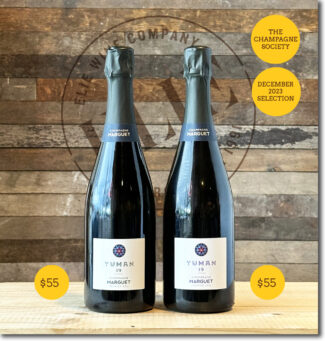Benoît Marguet’s Naturally Grown Champagne Channels His Biodynamic & Homeopathic Practices
True disciples call it wine’s inevitable future, and even the naysayers are beginning to admit that after years of practicing biodynamics, the dividends are irrefutable. And nowhere in Champagne is this more evident than at Champagne Marguet, where Benoît Marguet is one of the few growers in the region to have thrown himself, both body and soul, vineyard and cellar, into homeopathy.
It’s easy to think of Champagne as a spiritual substance; after all, it was created by monks and the very airiness of its identity seems celestial. The cornerstone of biodynamics is a view of the vineyard, and its subsequent produce, in like terms—as a singular organism capable of self-healing and self-propagation. Natural material alone sustains the soil; chemical fertilizers and pesticides are forbidden and instead, a range of animals are encouraged to create a rich, fertile environment in which the vines can thrive.
For Benoît Marguet, this goes beyond biodynamics as a concept; it’s a vision of complete harmony in every stage of winemaking and an improvement in his own personal life which translates into his Champagne.
The Montagne de Reims: A Sea Of Pinot Noir
Forming a broad and undulating headland that covers five thousand acres of thicket and vineyard, the Montagne de Reims stretches 30 miles east to west and, north to south, is about five miles wide. The vines hug the limestone slopes of the western and northern flanks and are planted in a huge semicircle that extends from Louvois to Villers-Allerand.
This is Pinot Noir country (except in Trépail and Villers-Marmery, where the Chardonnay can be found). The most northerly of Champagne’s four demarcated regions, the Montagne de Reims is also the most well-known, with more Grand Cru sites than anywhere else in the AOP. Tectonics gave the region mountains of chalk, and the Romans added their two cents by leaving behind huge limestone pits known as crayères. Within, the humidity remains at around 60% and temperatures at a steady 57°F; perfect cellaring conditions to soften the cold-climate acids of Champagne with time on lees. As a result, Louis Roederer, Ruinart, Veuve Clicquot, Krug, Taittinger and Mumm all store wine here.
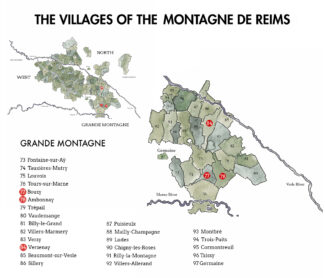
Champagne Marguet
“A Vitality About The Fruit That Makes It Feel Truly Alive.”
Champagne Marguet has been a bellwether for innovation since 1883, the year that Émile Marguet began to graft his vines onto American rootstocks in the face of the impending invasion of phylloxera. Alas, so ridiculed was the notion throughout Champagne that Marguet wound up tearing out the grafted vines and promptly declared bankruptcy.
Ratchet forward a century and a half: In 2006, Émile Marguet’s distant scion Benoît Marguet joined forces with Hervé Jestin, the former chef de cave of Duval-Leroy, and began to produce a special homeopathic and biodynamic super-cuvée called ‘Sapience’, first released in 2013. Being on the cutting edge of trends has finally paid dividends.
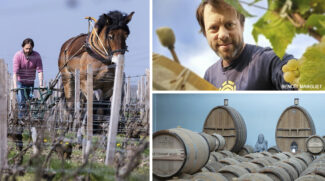
Today, Benoît farms 25 acres of vines, all using biodynamic practices. Most are owned by Marguet himself while the rest are leased from relatives. Among them are eight different lieux-dits with an average vine age of 42 years; each is bottled under the name of the plot and reflects the minute soil differences that exist throughout his holdings as well as the Massale-select varieties he suits to his various terroirs—among them Les Crayères, Les Bermonts, Le Parc and Les Saints Rémys.
The Horses, The Vines and The Eggs
Two techniques keep Benoît Marguet close to his passion; first, since 2009, he has plowed his acres with a pair of draft horses. He argues that by using this method of cultivation roots are forced deeper towards the water table surface, providing a better water supply. In addition, he treats the soil with preparations made of essential oils, tisanes, nettles, citronella, lavender and rhubarb. “The well-being of the soil is a priority,” he points out. “The horse is in connection with the three elements of terroir, the mineral (chalk), the vegetal (vine and flora) and the animal (fauna and human interaction).”
Next, in the cellar, he continues to adhere to the principles of biodynamics by working the wine according to lunar cycles. Under the conviction that the shape of a vat can affect the quality of the wine, he installed special 40-hectoliter egg-shaped wooden cuvée casks produced to his specifications by Tonnellerie Taransaud. The unique shape provides a height/width ratio equal to the Golden Mean or Phi, which Benoît believes is a natural feature repeated throughout the physical world and encourages spiral convection currents and a harmony to better clarify the wine… and his own purpose.
“This symbiosis, with the principle of nature assisting nature, is fascinating research work for me, with influences from various cultures and countries,” Benoît maintains. “In my opinion these fundamental or elemental practices are solutions that instill within our wine its full health benefits, and perhaps even more…”
Blanc de Blancs vs. Blanc de Noirs: Revealing The Fruit
The introductory lesson in Champagne Appreciation 101 is that sparkling wine is made from either light-skinned or dark-skinned grapes, or a combination of both, and all can end up looking a lot the same. This holds especially true in cool-weather climates like Champagne, where vinifying slightly under-ripe grapes is the norm—a point when Pinot Noir and Meunier may not have fully developed their juice-staining anthocyanins. To maintain the desired hue, of course, dark-skinned grapes are pressed gently to keep the skins from bleeding into the juice and the skins separated out quickly.
Holding equally true is the fact that looks can be deceiving. Blanc de Noirs Champagnes made with Pinot Noir and/or Meunier do not share a flavor profile with a Blanc de Blancs made from Chardonnay, and this is the result of both nature and nurture. Generally speaking, a Blanc de Blancs will be a bit lighter and dryer, showcasing the fruits that predominate in Chardonnay’s arsenal—white peach, citrus, green apple and pear. Blanc de Noirs tend to have more body, creamier texture, and the fruit contours are often red; cherry and raspberry, and toasty notes may be more emphatic.
Naturally, the only true lesson in that appreciation course is determining for yourself if you prefer one over the other, and since we are dealing with Champagne, you are more than welcome to respond, “All of the above.”
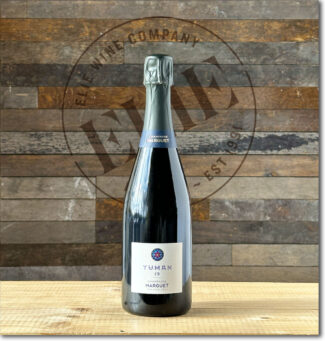 Champagne Marguet ‘Yuman 2019’ Premier Cru Blanc de Noirs Brut Nature D-2/2022
Champagne Marguet ‘Yuman 2019’ Premier Cru Blanc de Noirs Brut Nature D-2/2022
Yuman is a newer project of Benoit’s that uses organic/biodynamic fruit from two producer friends in Champagne. It is not an estate wine, but is treated just like his other cuvées, seeing a natural fermentation in barrel, and 36 months on the lees. Built upon 100% biodynamic-certified Pinot Noir from the Grand Cru village of Verzenay and Premier Cru village of Cumières, it shows a characteristically crisp acidity behind rich raspberry coulis and aromas of freshly-baked graham cracker.
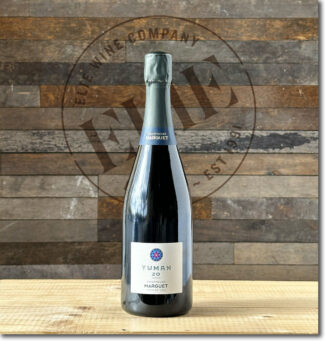 Champagne Marguet ‘Yuman 2020’, Premier Cru Blanc de Blancs Brut Nature D-3/2023 (Sold Out)
Champagne Marguet ‘Yuman 2020’, Premier Cru Blanc de Blancs Brut Nature D-3/2023 (Sold Out)
A cuvée based on the 2020 vintage; 100% organic Chardonnay sourced from Benoît’s friends Premier Crus Villeneuve-Renneville and Villers-Marmery in the Montagne de Reims. The wine is a wealth of intensity with crisp, chalky, mineral notes and perfumed Meyer lemon on the nose and palate.
Grand Cru Bouzy and Grand Cru Ambonnay: Always Rivals
Like the Hatfields and the McCoys (only without rebel flags and shotguns), Bouzy and Ambonnay have a longstanding rivalry built on begrudging respect and competitive moxie. At its closest point, the distance between the two communes is shorter than a long drive with a golf club, and each have shored up a reputation for superlative wines from the south side of the Montagne de Reims hill.
Yet connoisseurs will happily point out their favorite qualities in each, generally citing the special elegance of wines from Ambonnay, due in part to undulating, south-eastern exposures that moderate the ripening process.
In contrast, Bouzy exposures are almost entirely to the south, ideal for Pinot Noir. More than nine hundred acres in Bouzy are under vine, with 87% of them Pinot Noir, 12% Chardonnay and a scant 0.2% Meunier. The most prominent Champagne houses with a Bouzy presence are Bollinger, Duval-Leroy, Moët & Chandon, Mumm, Pol Roger and Taittinger.
Nearby Ambonnay shares a nearly identical terroir with Bouzy and is similarly appointed, although with slightly less Pinot Noir grown and a bit more Chardonnay—white grapes account for about 20% of the vineyards. Like Bouzy, ‘Ambonnay Rouge’ represents a small portion of wine production. Prominent Champagne houses that control Ambonnay vineyards include Duval Leroy, Moët & Chandon, Mumm, Piper Heidsieck, Pol Roger and Roederer.
2018 Vintage: Pinot Noir Ripened Perfectly. Chardonnay Is Outstanding. Climate Change Is Beginning To Make itself Felt.
2018 checked all the boxes for exceptional Vintage Champagne; the Pinot Noir crop ripened perfectly and the Chardonnay harvest created wines that are full-bodied yet fresh and promise to be long-lasting. Icing on the cake is that the vineyards produced copiously
A few isolated hailstorms led to some crop loss, notably in the Côte des Bar, but the hot, sunny dry days that followed were interrupted only occasionally by (welcomed) rain showers, keeping hydric stress at bay and allowing for optimal ripening at a gradual pace. Harvest was early, beginning on August 20.
Gilles Descôtes, Bollinger’s cellar master, relates his personal experience of the 2018 season: “I experienced this vintage as a relief. As in 2017, we began picking in August, but this time, everything was superb. 2018 is my 26th vintage and I have never seen anything like it.”
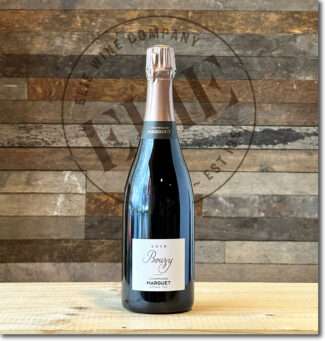 2018 Champagne Marguet Grand Cru Bouzy Rosé Brut Nature D-2/2023 ($95)
2018 Champagne Marguet Grand Cru Bouzy Rosé Brut Nature D-2/2023 ($95)
100% Pinot Noir from the chalky Bouzy terroir. Fermentation (on native yeast) and élevage is done in neutral oak and the wine is barrel-aged with long lees contact and full malolactic. The wine is juicy with ripe red berries and shows a fine bead that permeates a creamy, yet lively texture. 1275 bottles produced.
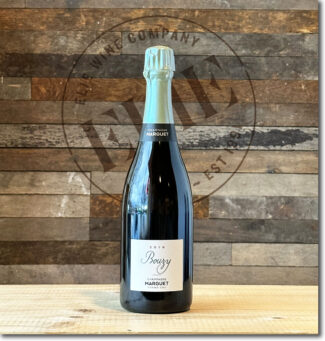 2018 Champagne Marguet Grand Cru Bouzy Brut Nature D-2/2023 ($90)
2018 Champagne Marguet Grand Cru Bouzy Brut Nature D-2/2023 ($90)
Fewer than 2175 bottles of this 100% Pinot Noir, zero-dosage Champagne from Benoît’s scant two acres in Bouzy. Having remained on lees for almost four years, the result is an opulent, powerful champagne with apple and yeast aromas and the slightly oxidative style Marguet is known for.
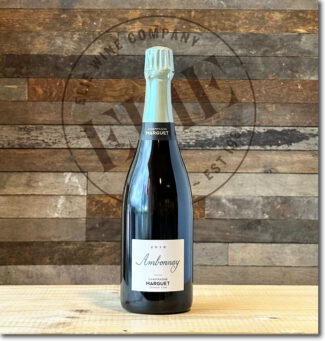 2018 Champagne Marguet Grand Cru Ambonnay Brut Nature D-3/2023 ($90)
2018 Champagne Marguet Grand Cru Ambonnay Brut Nature D-3/2023 ($90)
63% Pinot Noir and 37% Chardonnay that features a charming, biscuity nose with dried apple and lemon verbena braced by pure, shivery acidity and an underlying minerality.
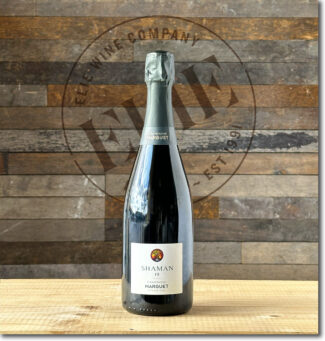 Champagne Marguet ‘Shaman 2019’, Grand Cru Brut Nature D-1/2023 ($66)
Champagne Marguet ‘Shaman 2019’, Grand Cru Brut Nature D-1/2023 ($66)
Grand Crus Ambonnay and Bouzy. 75% Pinot Noir and 25% Chardonnay. The nose shows candied ginger, dried flowers and orange blossom while the palate is creamy with marzipan, citrus and a salted nut finish.
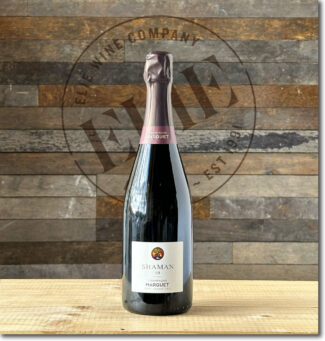 Champagne Marguet ‘Shaman 2019’, Grand Cru Rosé Brut Nature D-10/2022 ($66)
Champagne Marguet ‘Shaman 2019’, Grand Cru Rosé Brut Nature D-10/2022 ($66)
Grand Crus Ambonnay and Bouzy. 77% Chardonnay, 23% Pinot Noir vinified separately; Marguet works with a Burgundy-like system of Cru selections of single-village wine in good years, and lieux-dits in the best years. Wild strawberries and tea show on the nose, with beautifully integrated tannins and a long, yeasty finish.
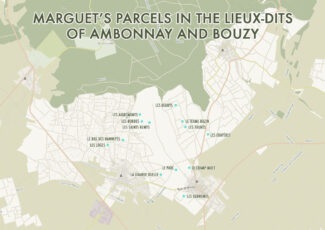
Site Specific Grand Cru Ambonnay
Whereas the ‘art’ of Champagne is often discussed in terms of expert blending—much as color is added in layers to create a portrait—a Cellar Master uses a pallet of flavors to create synergy, a whole that is greater than the sum of its parts. Traditionally, ‘house styles’ have been established over decades (even centuries) and homogeneity—in the best sense of the word—is the goal. Even vintage Champagne (assembled from a single harvest, though many villages may contribute) should highlight the house approach, since loyal customers expect as much.
So why are site-specific bottlings Champagnes growing popularity? In part because of the rising renown of grower/producers, who are highlighting individual plots of terroir that they themselves have developed. It is trendy (and completely correct) to regard Champagne as wine first and foremost, and as such, individual vineyard expression rather than cookie-cutter (however delicious) house style is simply a new way to view this old standby appellation.
Ambonnay’s vineyards are planted almost exclusively on south-facing slopes on the Montagne de Reims, mostly with Pinot Noir. Together with the vines of neighboring Aÿ and Bouzy, Ambonnay is the source of some of the most powerful Pinot Noir in Champagne; on the now-defunct ‘échelles des crus’, Ambonnay was rated 100%, making it a Grand Cru village.
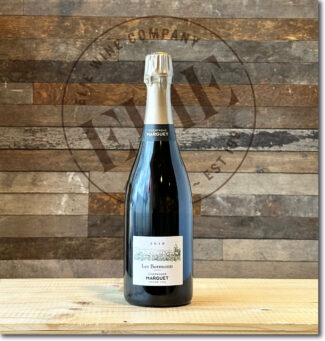 2018 Champagne Marguet Grand Cru Ambonnay ‘Les Bermonts’ Brut Nature D-3/2023 ($120)
2018 Champagne Marguet Grand Cru Ambonnay ‘Les Bermonts’ Brut Nature D-3/2023 ($120)
A Blanc de Blancs from Chardonnay vines planted in over an acre in 1952 at the base the slope, unusual for a Grand Cru village noted for its Pinot Noir. The wine features tangerine zest, salt and citrus blossoms behind acacia honey and a vibrant chalk-driven finish. 1848 bottles produced.
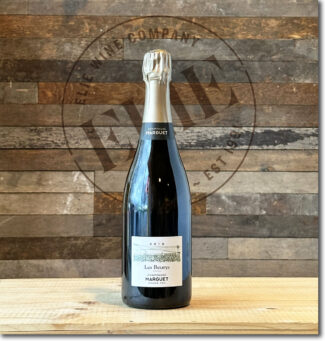 2018 Champagne Marguet Grand Cru Ambonnay ‘Les Beurys’ Brut Nature D-3/2023 ($120)
2018 Champagne Marguet Grand Cru Ambonnay ‘Les Beurys’ Brut Nature D-3/2023 ($120)
The east-facing chalky lieu-dit Les Beurys is slightly less than an acre of 35-year-old vines. The wine displays aromas of apricot, yellow plum and wild strawberry, currants with hints of spice, brioche, and white flower on the nose. Rich with great concentration on the palate, a juicy fruit core with a mineral edge, a fine and delicate mousse with great depth and a long spicy finish. 2141 bottles produced.
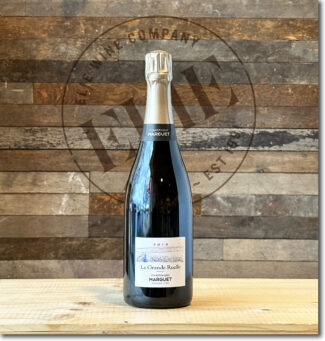 2018 Champagne Marguet Grand Cru Ambonnay ‘La Grande Ruelle’ Brut Nature D-3/2023 ($120)
2018 Champagne Marguet Grand Cru Ambonnay ‘La Grande Ruelle’ Brut Nature D-3/2023 ($120)
Marguet’s Ambonnay vineyard extends over 17 acres in the lieux-dits Les Saints Remys, Les Beurys, Les Crayères, La Grande Ruelle, Les Bermonts and Le Parc; ‘La Grande Ruelle’ 2018 is 100% Pinot Noir from a lieu-dit near Les Bermonts which Marguet believes in one of the best plots in Ambonnay. One acre planted in 1967, the vines thrive in deep clay and limestone soils. The draw took place in June 2019 and the wine was disgorged in March, 2023—only 2160 bottles were produced. The wine displays a great yeasty richness with stone fruit on the nose and a silken, elegant and precise palate.
Grand Cru Verzenay: Chalk About Champagne
It’s a fair bet that the citizens of Verzenay (oddly, called ‘bouquins and bouquines) love their windmill as much as the folks in Beaujolais’ Moulin-a-Vent love theirs. Verzenay’s sits on the Mont-Bœuf hill just west of the village and overlooks a portion of the vineland—1000 acres planted mostly to Pinot Noir. Verzenay Pinots tend to be darker in color than those of nearby Bouzy, where the slopes face south. Verzenay wines are also marked by a characteristic gaminess and an almost metallic undertone. And yet, at the same time, the north facing makes the wine somewhat lighter in weight and more tautly focused.
As usual, Verzenay’s terroir—beyond exposure—is about chalk, or more specifically, ‘super chalk’ built from the remains of microscopic, squid-like belemnites. This chalk sits near the surface in most of Champagne’s hallowed vineyard sites, including Grand Cru Verzenay, and here especially—Pinot Noir country—discredits the notion that such chalky substrate is better suited for Chardonnay.
But why? Above all else, chalk is a highly-efficient sponge, draining away excess water when it rains heavily but, crucially, storing water in times of drought. One cubic meter of pure chalk can store 660 liters of water, so vines in chalk can ride out not only heavy rains, but (increasingly) dangerous droughts which can strip the crop of its elegance and acidity.
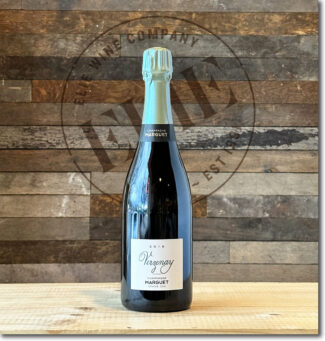 2018 Champagne Marguet Grand Cru Verzenay Brut Nature D-2/2023 ($90)
2018 Champagne Marguet Grand Cru Verzenay Brut Nature D-2/2023 ($90)
100% Pinot Noir. The nose is expressive with pretty aromas of stone fruit, pear skin, and wet stone; the palate is ripe and concentrated with Rainier cherry and Mirabelle plum. 2072 bottles produced.
The Sapience Project
Aided by a handful of like-minded individuals and completed in Marguet’s winery (with the help of Hervé Jestin), the Sapience Project utilizes the three dominant grapes of Champagne from biodynamic producers—Chardonnay from David Léclepart, Pinot Noir from Benoît Lahaye (and later from Marguet) and Pinot Meunier from Vincent Laval.
The first super-cuvée was in the 2006 vintage, and was named for the patience and experience to reach a full understanding of both the flavors and the concept.
Marguet’s spirit watches over the bottling, which occurs some 9 years from the harvest. It is a labor of love, a wine to ponder, to embrace, and to spend time with, to watch evolve, as the producers involved largely crafted this wine by virtue of decades of dedication to farming.
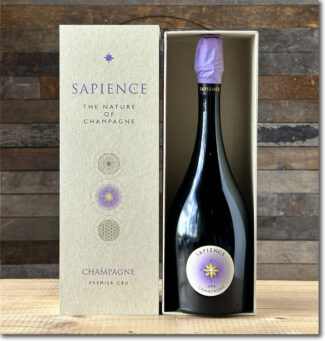 2014 Champagne Marguet ‘Sapience’ Premier Cru Brut Nature D-3/2023 ($200)
2014 Champagne Marguet ‘Sapience’ Premier Cru Brut Nature D-3/2023 ($200)
Terroirs Grand Cru Bouzy and Premier Crus Cumières and Trépail. Opinions of the 2014 vintage were mixed at the outset (plenty of rain fell throughout the summer) but at disgorgement, the wines have proven sturdy and delightful. 50% Chardonnay, 25% Pinot noir and 25% Meunier, the wine is a study in elegance brightened with freshness, showing creamy lemon curd, spring flowers, hazelnut and a trace of smokiness.
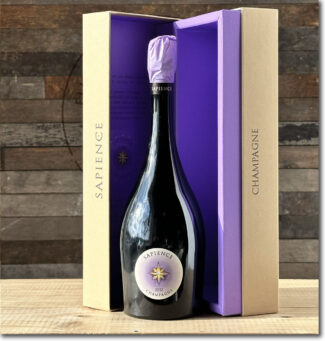 2012 Champagne Marguet ‘Sapience’ Premier Cru Brut Nature D-03-2022 ($200)
2012 Champagne Marguet ‘Sapience’ Premier Cru Brut Nature D-03-2022 ($200)
2012 was an excellent vintage for Champagne was despite the growing season throwing enough curve balls to make most producers nervous. Here, the base wine spends two years aging on forest-selection barrels before the second fermentation. With fewer than 3000 bottles made, it is rare, and has consistently been rated as highly as (or higher than) Salon and Krug.
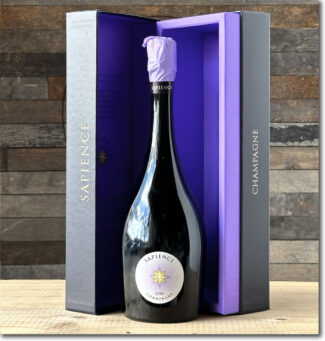 2010 Champagne Marguet ‘Sapience’ Premier Cru Brut Nature D-01-2020 ($220)
2010 Champagne Marguet ‘Sapience’ Premier Cru Brut Nature D-01-2020 ($220)
A blend of 50% Chardonnay, 25% Meunier and 25% Pinot Noir from vintages 2006, 2007, 2008, 2009, 2010, 2011 and 2012, the wine is a cooperative effort between four top biodynamic growers, Benoît Marguet, Benoît Lahaye, Vincent Laval and David Leclepart: Leclepart provided the Chardonnay, Lahaye the Pinot Noir and Laval the Meunier, while the vinification was done in Marguet’s cellar. The base wine spends two years aging in barrels before the second fermentation in bottle. With the balance and effortlessness of the best grand marques and the depth of terroir of the best grower Champagnes, the wine provides a creamy nose with hints of dried fruit; warm nut-bread flavors on the palate that are in absolute harmony with the wine’s vibrant minerality.
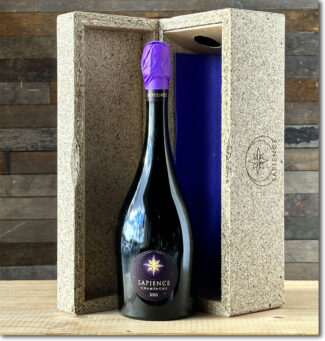 2010 Champagne Marguet ‘Sapience Oenothèque’ Premier Cru Brut Nature D-3/2023 ($280)
2010 Champagne Marguet ‘Sapience Oenothèque’ Premier Cru Brut Nature D-3/2023 ($280)
Produced only in 2007, 2008, 2009 and 2010, this meticulously crafted wine is a blend of 50% Chardonnay, 25% Meunier and 25% Pinot Noir from prized terroirs in Trépail, Cumières and Bouzy. Disgorged in March 2023 and bottled without dosage, the 2010 Brut Nature Premier Cru offers aromas of fresh pastry, golden apples, white flowers and walnuts followed by a full-bodied, layered and concentrated palate that’s vinous and intense with elegant structure and a sapid finish.
Coteaux Champenois: A Nod To Burgundy
The tale of Champagne’s proximity to Burgundy is told in varieties; Pinot Noir and Chardonnay make up 81% of Coteaux Champenois’ plantings. Also allowed is the other Champagne staple Pinot Meunier along with less cited Arbane, Petit Meslier and the Pinot derivatives, Pinot Blanc and Pinot Gris.
Like their fizzy sisters, still wines from the region tend to be dry and light-bodied with naturally high acidity. The reds are better in warmer vintages, which is why the predominant red variety, Pinot Noir, is currently basking in the newfound heat waves of northern France. The reason that 90% of the Coteaux Champenois output is red is not necessarily because the terroir has traditionally favored Pinot Noir, but because locally grown Chardonnay has commanded a higher price when sold to Champagne houses.
But a new generation of grower/producer is taking advantage of the more consistent ripening of red grapes, including Pinot Meunier, to explore terroir and individual lieux-dits in a manner more familiar in Burgundy than Champagne. Says Simon Normand of Domaine La Borderie: “Here in the Côte des Bar we feel quite close to our Burgundian cousins. Many local young winegrowers, such as myself, studied in Burgundy rather than in Champagne.”
Also from the Coteaux Champenois is a unique still rosé called Rosé des Riceys, once a favorite of the Sun King, Louis XIV. Made in tiny quantities by only a small handful of producers, Rosé des Riceys is made through the semi-carbonic maceration of Pinot Noir grapes and can have exceptional aging potential for still rosé.
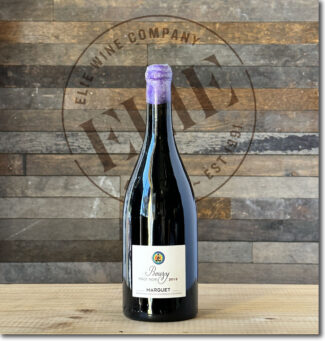 Domaine Marguet, 2018 Coteaux Champenois ‘Grand Cru Bouzy’ Red ($110)
Domaine Marguet, 2018 Coteaux Champenois ‘Grand Cru Bouzy’ Red ($110)
Produced only in 2007, 2008, 2009 and 2010, this meticulously crafted wine is a blend of 50% Chardonnay, 25% Meunier and 25% Pinot Noir from prized terroirs in Trépail, Cumières and Bouzy. Disgorged in September 2020 and bottled without dosage, the 2010 Brut Nature Premier Cru offers aromas of fresh pastry, golden apples, white flowers and walnuts followed by a full-bodied, layered and concentrated palate that’s vinous and intense with elegant structure and a sapid finish.
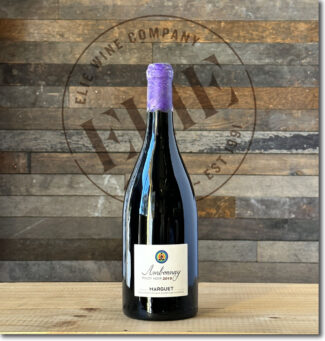 Domaine Marguet, 2018 Coteaux Champenois ‘Grand Cru Ambonnay’ Red ($110)
Domaine Marguet, 2018 Coteaux Champenois ‘Grand Cru Ambonnay’ Red ($110)
Pinot Noir requires more hang-time on the vine to fully ripen, and Marguet only produces red Coteaux Champenois in exceptionally warm years; 2018 was one of them. Les Saint Rémys is a parcel of 100% Pinot Noir located on the west side of Ambonnay near the border of Bouzy and produces a lightly-toned red wine with plum, raspberry and sloe on the nose followed by a silky, fruit-driven palate with the tug of stony minerality.
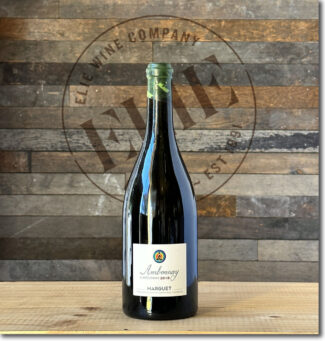 Domaine Marguet, 2018 Coteaux Champenois ‘Grand Cru Ambonnay’ White ($110)
Domaine Marguet, 2018 Coteaux Champenois ‘Grand Cru Ambonnay’ White ($110)
100% biodynamically-farmed Chardonnay from lieux-dits Les Saints Rémys and Le Parc; the nose is floral with aromas of apple white peach blossom, while the palate is concentrated with bees-wax and orange oil flavors with an intense chalkiness at its core. The Grand Cru finish is long and layered.
Notebook ….
Drawing The Boundaries of The Champagne Region
Having been defined and delimited by laws passed in 1927, the geography of Champagne is easily explained in a paragraph, but it takes a lifetime to understand it.
Ninety-three miles east of Paris, Champagne’s production zone spreads across 319 villages and encompasses roughly 85,000 acres. 17 of those villages have a legal entitlement to Grand Cru ranking, while 42 may label their bottles ‘Premier Cru.’ Four main growing areas (Montagne de Reims, Vallée de la Marne, the Côte des Blancs and the Côte des Bar) encompass nearly 280,000 individual plots of vines, each measuring a little over one thousand square feet.
The lauded wine writer Peter Liem expands the number of sub-regions from four to seven, dividing the Vallée de la Marne into the Grand Vallée and the Vallée de la Marne; adding the Coteaux Sud d’Épernay and combining the disparate zones between the heart of Champagne and Côte de Bar into a single sub-zone.
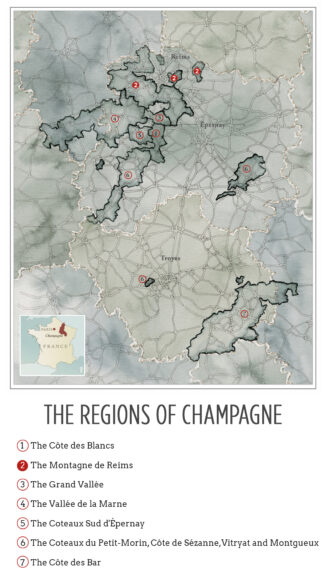
Lying beyond even Liem’s overview is a permutation of particulars; there are nearly as many micro-terroirs in Champagne as there are vineyard plots. Climate, subsoil and elevation are immutable; the talent, philosophies and techniques of the growers and producers are not. Ideally, every plot is worked according to its individual profile to establish a stamp of origin, creating unique wines that compliment or contrast when final cuvées are created.
Champagne is predominantly made up of relatively flat countryside where cereal grain is the agricultural mainstay. Gently undulating hills are higher and more pronounced in the north, near the Ardennes, and in the south, an area known as the Plateau de Langres, and the most renowned vineyards lie on the chalky hills to the southwest of Reims and around the town of Épernay. Moderately steep terrain creates ideal vineyard sites by combining the superb drainage characteristic of chalky soils with excellent sun exposure, especially on south and east facing slopes.

Single Harvest vs. Vintage
In France, under Appellation d’Origine Contrôlée (AOC) rules, vintage Champagnes must be aged for three years—more than twice the required aging time for NV Champagne. The additional years on the yeast is said to add complexity and texture to the finished wine, and the price commanded by Vintage Champagne may in part be accounted for by the cellar space the wine takes up while aging.
On the other hand, a Champagne maker might prefer to release wine from a single vintage without the aging requirement; the freshness inherent in non-vintage Champagnes is one of its effervescent highlights. In this case, the wine label may announce the year, but the Champagne itself is referred to as ‘Single Harvest’ rather than ‘Vintage’.
A Gift That Keeps On Giving
Membership To ‘The Champagne Society’
Bimonthly Subscription
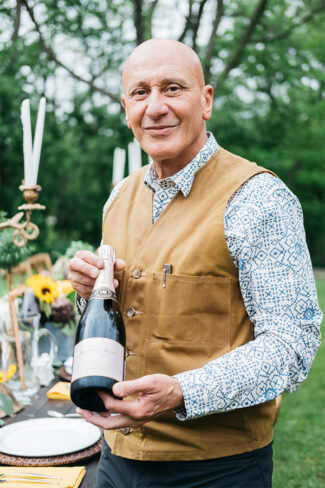 Not only is Champagne the quintessential drink of celebration, it has traditionally been a gift given with ramped-up sentiments. This year we are offering a couple of variations on this theme, beginning with an opportunity to gift a special someone a six-month or twelve-month membership to The Champagne Society. Our pick for December will be packaged in a wrap-ready gift box along with a congratulatory certificate explaining what lies ahead in bi-monthly installments. For more information please visit our website page: A Holiday Gift: ‘The Champagne Society’ Membership 6-Month ($299) or 12-Month ($589) Subscription.
Not only is Champagne the quintessential drink of celebration, it has traditionally been a gift given with ramped-up sentiments. This year we are offering a couple of variations on this theme, beginning with an opportunity to gift a special someone a six-month or twelve-month membership to The Champagne Society. Our pick for December will be packaged in a wrap-ready gift box along with a congratulatory certificate explaining what lies ahead in bi-monthly installments. For more information please visit our website page: A Holiday Gift: ‘The Champagne Society’ Membership 6-Month ($299) or 12-Month ($589) Subscription.
Elie
- - -
Posted on 2023.12.24 in France, Champagne, Wine-Aid Packages | Read more...
Back To The Roots Of Wine: A List Of Trios Showcase The Diversity Of France’s Wine Regions A Fresh Look Into What Makes The Country The Wine World’s North Star
The world is a galaxy of wine, and at its center lies a vinous, red-and-white hole of such density that all other wine regions tend to circle it, drawn by the gravity of its reputation and know-how. These other regions are not necessarily ‘pretenders’ and indeed, some of the students have at times transcended the master. They are satellites drawing energy from a mothership called France: Cabernet Sauvignon and Sauvignon Blanc, Pinot Noir and Chardonnay, all are benchmark varieties in nearly every pocket of the planet that can support them.
Through ups and downs, missteps and natural disasters, the immensity of this tug remains, and at Elie’s, it remains irresistible, even if it may be time to paint over the Mona Lisa.
France has always been its own best friend and worst enemy; a truism in times of war and peace. An epicenter for cuisine and fine wine, it has tended to rest on its laurels a bit too long, until reputation became a stand-in for quality. And then, waking up, in a desperate attempt at reinvention, it has occasionally strayed down rocky roads. Still, the French begin with an advantage denied nearly everyone else—spectacular terroir across the whole of its wine producing regions. Rebounding from the blunders of the late twentieth century, when Robert Parker Jr.’s vaunted love of amplitude over austerity, plushness over earthiness, accessibility over ageability, caused some French vignerons to trade their gracefully-composed French styles for the warm-weather lavishness of Napa’s style, and the changing climate cooperated by stringing together hotter, drier vintages more than capable of producing this sort of wine.
But despite the focus of the mainstream press, the soul of French wine has always been found in the beautiful countryside, and as a younger generation of winemakers comes of age, and embraces new/old concepts like biodynamics and revitalized vineyard soil, there is New French wine movement taking hold. The depredations of industrial farming is beginning to be seen in a rear-view mirror and once again, the concept of ‘terroir’ is not viewed as a marketing tool; it is seen as an indispensable passport to identity.
As die-hard fans and unabashed Francophiles, Elie’s is pleased to be at the forefront of discovery, especially when new faces appear at old venues. Some are scions, others pioneers, but the fact remains that now, and for the foreseeable future, French wines not only matter, but when they live up to their best ideals, remain the lodestar for the global wine industry.
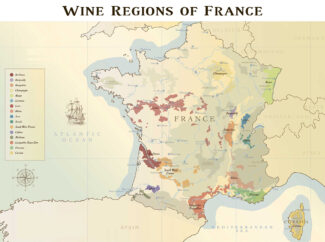
The New Frence: Neoclassicism and ‘New Wave’ Wines. (The Myth of An Immutable France.)
Terroir may be written in stone (and soil and climate) but culture is not. Although wine represents the most valuable sector of French agriculture, the attitude of the people toward it has changed rather dramatically over the past few decades. Wine consumption in France is half what it was in the 1960s; younger generation that has turned away from wine more than any other age group. In February 2023, Agriculture Minister Marc Fesneau announced plans to help the industry respond to what he described as a ‘crisis in the wine sector’, including financial aid for producers wishing to distill excess wine and supporting growers by developing longer-term plans in light of climate change challenges and evolving consumption patterns.
In the meantime, the ever-resilient old guard, refreshed with novel ideas as a new generation takes the reins, has laid the ground work for what author Jon Bonné refers to as ‘neoclassicism’—a return to the roots, where wines taste more transparently of its origin, and regions not previously regarded for quality have discovered that a host of new techniques—bolstered by warmer, drier weather—has transformed outlying appellations from blips on the radar to regions that demand our attention. And in a land where time-honored tradition is sacred, this shift in thinking is nothing short of seismic.
At Elie’s we have followed these trends with our own personal microscope, wandering the hectares, talking to the vignerons, sampling from cellars full of this new-wave of French wines. As France is not immutable, neither are we, and armed with both a love for French wine and a fascination with its expansive evolution, we will do our best to be the most comprehensive source of neoclassical French wines on this side of the Atlantic.
Climate Change Pushes Vignerons To Rethink Winemaking Practices
Freak frosts and soaring temperatures, devastating droughts and downpours, sultry winters that encourage vines to bloom before their time—these are mere symptoms of the larger condition (which may, in many cases, be called a catastrophe) known as global warming. In France, where many vineyards exist in a precarious ‘Goldilocks zone’ of grape viability, this phenomenon has forced changes in such practices as have seen winemakers through centuries.
Short of lighting up hundreds of flaming candles and using the downdraft from helicopters to protect precious young buds (as occurred across France in 2019), winemakers are clenching their hidebound teeth and replanting vineyards to previously ungrowable varieties. The Jura, for example, is producing higher-quality Pinot Noir than ever before and vintners are delving back in time to the historic varieties of the area that were abandoned decades ago. Producers are rethinking canopy management, vine trellising and pruning techniques, developing cover crops and extensive shading methods, increasing vineyard biodiversity and finding ways to reuse water during droughts.
Climate change is complicated, and even if temperature is the most influential factor in overall growth and productivity of wine grapes, there’s far more to consider: Rainfall is pivotal, and too much rain during harvest season can lead to watery grapes and a weak vintage, while humid conditions in the spring lays a welcome mat for pests, fungi and mildew. Rising sea levels play a role as well, and it is likely to get worse: According to NASA, oceans worldwide are estimated to surge at least 26 inches by 2100, and will decimate coastlines and their sway over nearby viticultural regions.
Alsace
According to many of us, the wines of Alsace are criminally under-represented on most wine lists and in most collections, but in this cool corner of northeast France is surfacing those eager to carry forward the torch. To each of them, a critical question arises: “Do I continue to make wines in the style my fathers and grandfather, or implement changes to show a different approach?”
Jean-Frédéric Hugel from Hugel in Riquewihr responds this way: “If you need proof of climate change, ask vintners; grapes and are great witnesses of it. At the beginning of his career my grandfather saw a regular harvest start on October 15th, so that’s when he brought in bring pickers to start a six-week harvest. Today we harvest in 4 to 5 weeks and start on average 15th of September and in 2018 and 2017, the 7th and 5th of September, with sugar content far higher than in later harvests of the past.”
Overall in Alsace, climate change has been a blessing, as in the past, the main challenge was ripening grapes. On average, the region once saw two unripe vintages per decade and produced wines that would have been unsellable in the current market. Now, they are rare, while the two ‘exceptional’ vintages per decade that Alsace once enjoyed has become four, and often, six.
$89 White Alsace Trio: Riesling, Gewürztraminer, Pinot Blanc
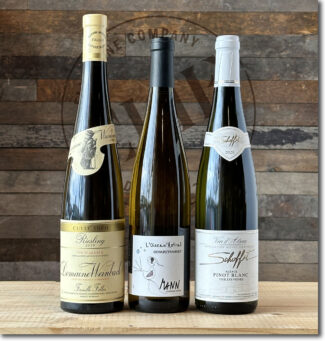
Alsace Riesling, Domaine Weinbach ‘Cuvée Théo’ 2019 white ($39)
An elegant, pure and aromatic Riesling from the Weinbach clos, made with biodynamic grapes; it offers ripe citrus on the nose, yellow peach on the palate and a salty-piquant finish with plenty of athletic acidity.
Alsace Gewürztraminer, Domaine Mann ‘L’Oiseau Astral’ 2020 white ($30)
‘The Astral Bird’ is an expressive Gewürz from Biodyvin-certified vineyards; it shows nice extracted fruit, with lychee and mangosteen in the forefront and spicy acidity that gives it remarkable length.
Alsace Pinot Blanc, Domaine Schoffit ‘Vieilles Vignes’ 2020 white ($20)
A blend of Pinot Blanc and Pinot Auxerrois, from a plot where the average vine age is fifty years. Expressive up front with musky floral tones and a succulent apple core, a wisp of sweetness, zesty acids and plenty of grip on the finish.
Burgundy
As writer Jon Bonné maintains, “It’s not that the world hasn’t always revered Burgundy, but the past two decades have been very good to this sliver of eastern France. The Côte d’Or has become the darling of wine lovers as no other place has—its popularity today is unprecedented and its best vineyards and producers are the stuff of modern legend. Fans pore over esoteric maps and data in a way that verges on fetish, and they pay dearly to celebrate with their fellow Burgundy lovers.”
Even so, at the turn of the twenty-first century, Burgundy was just beginning to recover from disastrous winemaking decisions that marked the late 1980s and early 1990s, when red Burgundies were often deeply extracted and thick and aged in too much new oak with the goal of emulating the bigger style of Pinot Noir gaining favor at the time. The whites, in contrast, had a tendency to oxidize prematurely.
These days, the requisite changes in thinking are being wrought by pioneering, educated and confident winemakers, many of whom are very young. Organics and biodynamics are understood as being the only logical choice to restore terroir (rather than marketing) as the essence of the Burgundian persona.
$142 Red & White Burgundy Trio: Givry, Mercurey, Rully
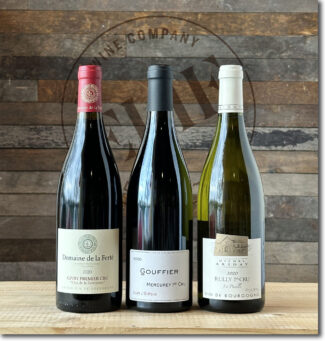
Givry, Domaine de la Ferté Premier Cru Clos de la Servoisine 2020 red ($44)
The Clos represents just under two acres of vines planted in the early 1970s in dense clay and silty soils. Natural yeast fermentation followed by aging in large foudres; the wine shows lush blackberry with an edge of dark chocolate and spice, supple tannins and a balanced finish.
Mercurey, Gouffier Premier Cru Clos l’Évêque 2020 red ($49)
Hand-harvested organically-grown grapes vinified 40% whole cluster and aged in 228 liter barrels for a year. It offers silken cherry notes, earthy forest floor, bramble berries and a lean, chalky finish.
Rully, Domaine Michel Briday Premier Cru La Pucelle 2020 white ($49)
From an acre and a quarter planted on shallow clay; this Chardonnay comes from 45-year-old vines and shows richly concentrated citrus notes, green apple, white flowers and a touch of toast and flint on the finish.
Beaujolais
‘Beaujolais Nouveau’ may stir up some unpleasant memories, but New Beaujolais—coming of age during the global climate crisis—is different sort of critter. The pitfalls are legion: “It’s easier to find a drought-resistant grape variety than it is to convince both producers and wine-loving public to drink it,” says Natasha Hughes, MW. For Beaujolais, a one-trick pony named Gamay, the experimental mix of Alsace and Rhône varieties may be a hard sell, but it forms a component of research by Sicarex—an organization working on behalf of Beaujolais to mitigate the worst excesses of climate change.
Even so, that is not how the story of modern Beaujolais will likely resolve itself. Gamay will not only survive intact, it may well become a younger generation’s substitute for the red Burgundy they cannot afford and are likewise unwilling to invest the time required for it to reach full maturity. Wines built for upfront drinkability, made without status markers like new oak, are becoming not only acceptable, but embraced as great wines. Beginning in the 1980s, a group of Beaujolais winemakers began to reconsider farming practices and cellar work, believing that ripe fruit and diligent, controlled winemaking with native yeasts could make far better Beaujolais. Their legacy is obvious today, and Beaujolais—the Crus especially, but not exclusively—are a totem of how wine itself has changed.
$125 Red Beaujolais Trio: Morgon, Fleurie, Moulin-à-Vent
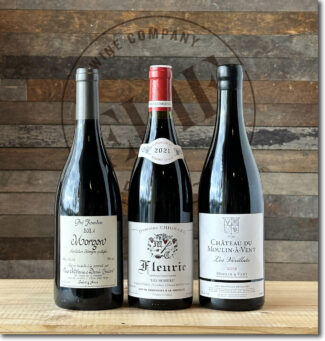
Morgon, Mélanie et Daniel Bouland ‘Pré Jourdan’ 2021 red ($39)
Ample and fleshy, the wine displays a rich nose of raspberries, cherries and sweet spices, with espresso, wood smoke and ripe tannins in the mid-palate.
Fleurie, Domaine Chignard ‘Les Morier’ 2021 red ($29)
‘Les Morier’ is an exceptional vineyard, steep and stony with a granite core, and a portion of it reaches into Moulin-à-Vent—an appellation known for its structural depth and Rhône-like aromatics. True to form, the wine is velvety and fleshy, showing mulberry and cherry preserves over a focused, elegant nucleus.
Moulin-à-Vent, Château du Moulin-à-Vent ‘’Les Vérillats’ 2019 red ($57)
At 1000 feet, Les Vérillats perches atop the hill, even above the famous windmill, where a thin layer of sand covers pink granite. 45-year-old vines give the wine enviable depth and structure to support notes of mature red and black fruit, hints of spice and a persistent floral river of rose, peony and violet.
The Loire
The Loire, from Muscadet to Sancerre, is another French wine region that is changing so rapidly that it is difficult to keep up. The natural wine movement finds its unofficial headquarters here, and if the gorgeous châteaux and picturesque chalky-limestone villages speak to the past, the winemakers have their sights set on the future. Whereas the Loire’s white wines have long held a reputation for their remarkable depth, particularly among white Burgundy lovers seeking an affordable substitute, and the reds, generally made from Cabernet Franc, have legions of Bordeaux fans, they are increasingly seen as something more than an alternative wine. They have established a modern reputation of being soulfully complex and savory, remarkably expressive of their individual terroirs.
“In the 1980s, the wines were known for being easy and simple,” says Matthieu Vallée of Château Yvonne, one of Loire’s up-and-coming talents. “Now it’s finally changed, and people can see a different side.”
$97 White Loire Trio: Muscadet Sèvre-et-Maine, Sancerre, Montlouis-sur-Loire
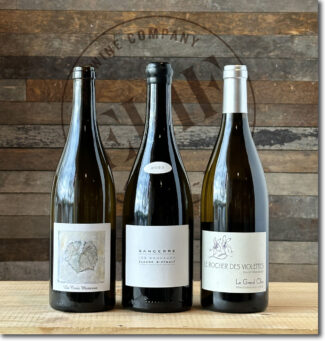
Muscadet Sèvre-et-Maine, Complemen’ Terre ‘La Croix Moriceau’ 2021 Natural white ($29)
The Melon de Bourgogne grapes are manually harvested and stainless steel tanks are used for débourbage before racking into smaller concrete vats for fermentation and elevage for 7-8 months. The wine then undergoes malolactic fermentation, and minimal sulfur is added at bottling. The wine is racy and tight, with macerated apple notes and a slight, pleasant oxidation and on the finish to accompany crushed stone, salinity and a whiff of campfire.
Sancerre, Domaine Claude Riffault ‘Les Boucauds’ 2022 white ($36)
The Sauvignon Blanc grapes are grown in the deep clay of Les Boucauds lieu-dit, which lends fullness to the fruit and produces a tropical profile with melon, pear and pineapple alongside white flowers.
Montlouis-sur-Loire Sec, Le Rocher des Violettes “Le Grand Clos” 2020 white ($32)
The Chenin Blanc grapes originate in three lieux-dits in Mont-Louis, Les Borderies, Le Grand Clos and Bel Air. These are the oldest vines of the estate (90+ years old) and are subjected to high density plantings on south facing slopes where the terroir is clay and silex above pure chalk. The wine shivers with crystalline acidity and shows flecks of richness amid white flowers, ripe lemons and subtle honeyed notes.
Bordeaux
Dollar for dollar, Bordeaux produces more wine than anywhere else in France; its marketing power, reputation and history have impelled it to a pinnacle in the imagination of most of us. Still, the perch is precarious, in part because it has largely been built around the 1855 classification system that ranks its top properties. And nearly everyone not atop that pyramid views it as past its expiration date.
Of Bordeaux’s 8,500 properties, only about 120 benefit from this hierarchy, and if ever a wine region was screaming for an updated perspective, it’s Bordeaux.
Even the hidebound Conseil Interprofessionnel du Vin de Bordeaux (the Bordeaux Wine Council, formed in 1948) seems on board. Six new grapes join Bordeaux’s previously approved varieties in an effort to adapt to climate change, and the area home to a growing number of producers making eminently drinkable wine at artisan scale, while avoiding the style wars that have fueled the region’s woes.
As can be seen elsewhere in France, biodynamics and biodiversity, and often, lighter extractions closer to the classic ‘claret’ style, is a stand against the hive mind in Bordeaux. This is being driven by vignerons rather than public relations firms, people who believe in human-scale Bordeaux and who farm with an eye toward organics and who revere the freshness and integrity that has made the region so beloved.
$124 Red Bordeaux Trio: Saint-Estèphe, Saint-Émilion, Pessac-Léognan
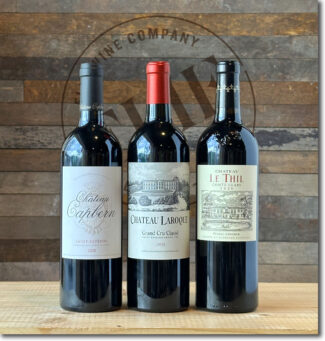
Saint-Estèphe, Château Capbern 2020 red ($38)
A Cabernet Sauvignon-dominated blend that includes 37% Merlot and 1% Petit Verdot, all of which was brought up in 60% new barrels, resulting in a deep, dark, earthy, classic Saint-Estèphe with cassis and blueberry as well as ample chocolate, damp earth and leafy herb-like aromas and flavors.
Saint-Émilion, Château Laroque Grand Cru Classé 2018 red ($44)
97% Merlot and 3% Cabernet Franc from one of the highest sites in the appellation. The wine shows flamboyant notes of stewed plums, Black Forest cake and boysenberries plus hints of candied violets, star anise and tobacco leaf with a waft of sassafras.
Pessac-Léognan, Château le Thil Comte Clary 2020 red ($42)
Blackberries, currants and hints of hazelnut form the framework of a sensuous and lithe wine with multiple spice nuances—cloves, ginger and soft mint.
The South-West
Nowhere in France is the notion that ancient grapes do best in their native soils more pronounced than in the southwest; critics and rule makers be damned. Some of these grapes grew wild, while others found places where they thrived after Roman soldiers and medieval troubadours carried them through hills and valleys. Though the cast is enormous, many of these vines are not found elsewhere and are varieties with which many of us are only peripherally familiar: grainy Négrette, small-berried Petit Manseng, local Tannat whose name, it is assumed, derives from its mouth-puckering tannin content. Some are grapes that have all but disappeared, but are now being revived by growers who revel in the homegrown DNA and are modernizing tradition rather than breaking with it.
Having at one time receded into the role of humble country wine, a new generation of vignerons in the southwest are beginning to produce remarkable, avant-garde wines. Natural-minded, new-wave winemakers are appearing on the scene with increasing regularity. They seem to have a deep appreciation for the nuance and depth of southern traditions, maintaining its bounty of local grapes and eager to connect best of the countryside’s past to the future. They are quiet heroes and quality-focused pioneers demanding change from the twentieth-century norm and the Southwest’s blandly commercial path.
$101 Red & White South-West Trio: Cahors, Côtes-de-Bergerac, Bergerac
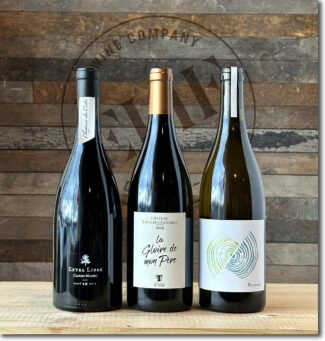
Cahors, Château du Cèdre “Extra Libre” Natural 2019 red ($31)
The winery eliminated the use of chemicals in 1992, emphasizing sustainable practices and minimal intervention in the vineyards—this blend is 90% Malbec, 5% Merlot and 5% Tannat, hand-harvested from vines between 15 and 30 years of age, fermented in concrete tanks, then aged 12 months in large, used barrels. The wine shows vibrant acidity, to brace its dark fruit, cocoa and very fine tannins.
Côtes-de-Bergerac, Château Tours des Gendres ‘La Gloire de Mon Père’ 2018 red ($31)
A blend of 53% Merlot, 35% Cabernet Sauvignon and 12% Cabernet Franc that spends 12 months in oak and six months in bottle before release. A smooth and creamy palate juicy with concentrated blackberry and cherry notes, a hint of smoke and a long, mineral-driven finish.
VdF Bergerac, Combrillac ‘Petchalba’ 2021 white ($39)
An interesting and unusual blend: 50% Sauvignon Blanc, 40% Sémillon and 10% direct-pressed Cabernet Sauvignon. Named for a Macedonian rite of passage, the wine is aged in a mix of Italian sandstone amphorae and used barrels and bottled without fining or filtering.
Jura
‘Voile’ is a term that most wine people associate with the Jura’s late-harvested Vin Jaune—a thin veil of yeast that floats atop the vat to toughen and mature the must, exposing it to limited amounts of oxygen. But in the Jura, it is used not only in their famed, sherry-like ‘yellow wine’, but in many others based on the local Savagnin variety.
It’s an interesting method, not to everyone’s tastes, and perhaps a problem as modern wine drinkers look more and more to terroir and less to technique. But the switch is not far-fetched in Jura, whose soil is somewhat similar to its grand neighbor to the west, Burgundy (both sit on an ancient seabed) and limestone and clay in varying configurations that can accommodate Chardonnay as well as Savagnin. Ironically, in Jura, the radical reinvention is to go more mainstream—Jura’s conventional winemaking is unconventional in the rest of France, and a growing number of winemakers believe that it blurs the region’s true potential.
“With the traditional style, all the wine was looking similar after oxidation with the veil,” says Julien Labet, one of the champions of the new style, called ‘ouillé.’ “They all had that nutty taste, and didn’t have the personality they had before the veil.”
Resistance has been marked, largely because the Jura enjoys its reputation as an outsider and frowns on any changes designed to erase its uniqueness. Still, there is little chance that the appellation will ever become ‘like everybody else.’ Chardonnay planted to densely spaced, head-trained on the Jura’s terroir yields wine that are more savory and saline than their Burgundian cousins, their fruit and flavors a bit more generous.
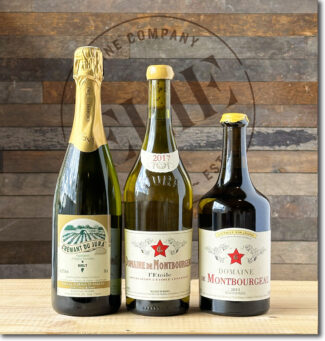
Crémant-du-Jura Brut, Domaine Overnoy-Crinquand ($33)
100% Chardonnay with 30 months of lees contact and a mere 0.5 grams per liter dosage. A non-vintage wine but produced exclusively from a single vintage, it offers textural plushness and breadth balanced by iron-tinged minerality and a gently honeyed character.
L’Étoile, Domaine de Montbourgeau 2017 white ($30)
95% Chardonnay with Savagnin topping off the blend, this wine originates on the southeastern slopes of L’Étoile, where vines average 40 years. Following malolactic fermentation, it spends up to three years in neutral oak, giving it what may be considered a ‘typical’ Jura profile for Chardonnay, tasting slightly oxidized, although not nearly in the style referred to locally as ‘sous voile’, or ‘under veil’—referring to the yeasty flor that characterizes Vin Jaune. About 20,000 bottles are produced: It is the winery’s mainstay.
L’Étoile, Domaine de Montbourgeau 2011 ‘Vin Jaune’ ($89)
Befitting the style, this Vin Jaune is 100% Savagnin grown on blue marl rich in limestone. The wine spends one year in small, neutral oak casks followed by six years in larger hogsheads, allowing for the longer, requisite maturation period. The wine displays quince jam notes sheathed in warm, yeasty lemon curd and resonant acidity. Around 3000 bottles made.
Savoie
Metaphors linking wine to its place of origin are the stuff of poetry, but they’re also the foundation of terroir. Among the most common descriptors of the area’s high-altitude wine is ‘refreshing’ which is an offhand way of saying that it tends to be lower in alcohol and higher in acidity than valley wines. These acids are often the end result of the cool mountain air which they resemble, giving distinct, cleansing mineral characteristics to the wine with citrus and herbs rather than jammy fruit. Alpine wines have a crunchy sizzle and a cool sappiness unlike wine from anywhere else. Not only that, but the predominant grapes don’t show up on many other radars, so the unique textures commingle with a whole new flavor profile to surprise and delight the palate.
Over the past twenty years, a new wave of independent vignerons has been boosted by organizations dedicated to preserving these singular grape varieties, and Savoie has finally begun to come into its own. Natural wine is increasingly becoming the order of the day—elevations are such that the mildew that affects vines at sea level is not an issue, and like wines from the Jura were a decade ago, Savoie wines are still considered somewhat geeky and under-the-radar—which makes it an ideal region for innovative winemakers from a younger generation to make their mark.
$114 Red & White Savoie Trio: Savoie, Savoie-Arbin, Roussette-de-Savoie
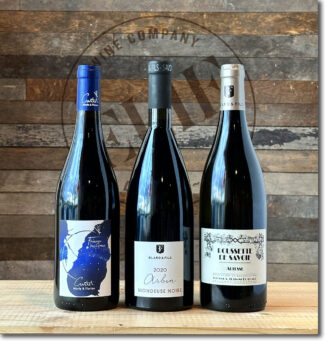
Vin de Savoie, Domaine Marie & Florian Curtet ‘Frisson des Cimes’ Natural 2019 red ($45)
An interesting blend of organically-farmed Mondeuse, Gamay and Pinot Noir planted in sandstone with a southwestern exposure. It is made with whole cluster fermentation and without pump overs, which lasts around a month before pressing. This is a dark, pungently earthy wine with notes of mulched forest floor, black plum, blueberries, pine, Kalamata olives and roasted meat.
Vin de Savoie Arbin, Blard & Fils ‘Mondeuse Noire’ 2020 red ($39)
Mondeuse is a local variety often described as a cross between Pinot Noir and Gamay with a touch more tannin. This offering is grown in clay and limestone soils and there is a pronounced iron-rich mineral note on the nose along with red fruit and lacy mouthfeel.
Roussette de Savoie, Blard & Fils ‘Altesse’ 2020 white ($30)
Made from 100% Altesse grown on Mont Granier scree—a mix of clay and limestone with a bit of marl and silex. 80% of the grapes are direct-pressed while 20% are destemmed and macerated on the skins for 10 days. The wine is wild yeast fermented and aged on the skins in stainless steel tanks for 10 months and bottled without filtering or fining. A nice backbone of acidity sets off notes of bergamot, honey and hazelnut, mountain herbs. As an aside, the traditional pairing for Roussette de Savoie is Raclette and its typical sides of boiled small potatoes, charcuterie, and apricot mustard.
The Rhône: North
Fifty years ago, both Côte-Rôtie and Cornas along with much of the northern Rhône, were struggling just to survive. Around 1966, when the appellation had fallen into obscurity, its overseers simultaneously decided to revive quality, but also to expand to the flatlands above its rocky granite and schist terraces. The appellation’s traditional method of farming steeply-sloping vines by hand made for pretty images, but were a curse financially. The expansion ended a traditional style of Côte-Rôtie that had been fresher, even a bit light, and more overtly spicy than fruity.
By the 1990s, the most popular wines of Northern Rhône were thick and heady, made with carefully controlled fermentations, heavy extractions and plenty of new oak. As the climate warms, the conditions that produce big, high-alcohol wines are becoming the rule of the day. Not only that, but rising temperatures parallel the rising cost of vineyard acres, and many properties are being snapped up by wealthy overseas investors who care more for market appeal than subtle winemaking.
But a number of smaller, previously dormant areas that nestle in pockets near the big-name appellations in the Rhône have begun a remarkable comeback; this is the result of hard work by few steadfast vignerons who have saved noteworthy properties from being reclaimed by forest. It is among these parcels of land, which peek through mostly unfriendly hinterland that we make our modern-day discoveries— worthy and exciting Syrahs; the best made since the phylloxera blight wiped out the original vineyards in the 1800s.
$124 Red Northern Rhône Trio: Côte-Rôtie, Crozes-Hermitage, Saint-Joseph
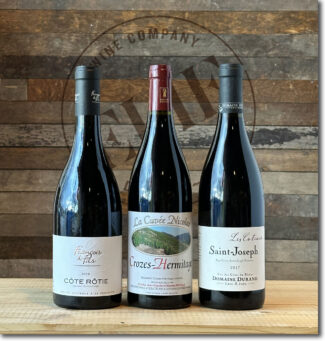
Côte-Rôtie, François & Fils 2019 red ($67)
Classic Côte-Rôtie notes of violets and crushed blueberries bathed in silky ripe tannins. A traditional co-ferment with 4% Viognier that offers a floral lift and a touch of nutmeg in the finish.
Crozes-Hermitage, Domaine Jean-Claude et Nicolas Fayolle ‘La Cuvée Nicolas’ 2020 red ($25)
100% Syrah from youngish vines grown in Gervans, a small granitic outpost within CrozesHermitage. Full-bodied without being heavy, ripe without being jammy, the wine is juicy with brambly wild berries, licorice and creamy mocha tones.
Saint-Joseph, Domaine Éric et Joël Durand ‘Les Coteaux’ 2017 red ($32)
Big-shouldered, yet velvety, concentrated and rich, the wine shows cherry and plum pudding infused with anise and accented by warm fruitcake spices.
The Rhône: South
2021 is an example of the sort of challenging vintage the producers in Southern Rhône are facing; a wet winter was followed by an unseasonably hot spring, followed by an extensive frost in April that drastically reduced yields. In November these climatic extremes reduced overall French wine production by 27 % and the vintage proved to be one of French wine’s most difficult years on record.
But the effects of climate change are hardly restricted to a single season. In recent years, each individual vintage has presented its own unique set of trials, an inevitable offshoot of rising temperatures, which on average have increased 1.5°C; predictions are that things will get worse. Of course, it’s not limited to France, but the delicacy of the vineyard ecosystem is Southern France is being battered by heat waves, drought and fires, there are also spring frosts, hail, and excessive rain with damage wrought by one or more in any given year.
As the world is eager for Rhône wine and winemakers understand they must be willing to provide enough of it, they look for a silver lining, even if it means rethinking France’s longtime wine regulations. As relatively new appellations like the villages of Gigondas and Vacqueyras gaining fame, attention has turned to other, as-yet-unexploited areas where climate change may be a blessing in disguise. Historically, elevation has not been a defining characteristic of the region, as the vast expanses of the Côtes du Rhône to Cru appellations like Châteauneuf-du-Pape, Gigondas and Vacqueyras, the vineland is characterized by rocky flatlands where ample sunlight pumps richness into the wines.
According to Christian Voeux, owner and winemaker of Domaine de l’Amauve, located just north of Gigondas, “In the past, altitude was not considered an advantage for winegrowers in Southern Rhône. High altitudes would delay the maturity of grapes, and when full maturity was finally reached at the end of September or October, heavy rains would come, affecting the quality of grapes.”
Over the last two decades, climate change has rewritten the rule book. Throughout the Southern Rhône, a steady annual increase in temperature has expanded the possibilities for viticulture into a diversity of hillside terroirs rimming the valley, while those on the ground level may suffer the fate of most grapes pushed extreme ripeness in shorter ripening cycles, yielding blowsier wines with lower acidity levels.
$137 Red Southern Rhône Trio: Châteauneuf-du-Pape, Gigondas, Lirac
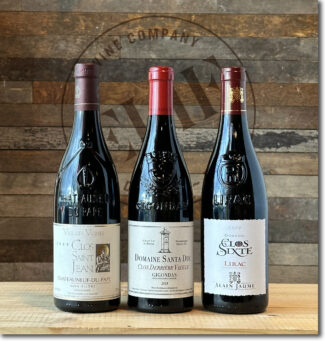
Châteauneuf-du-Pape, Clos Saint Jean ‘Vieilles Vignes’ 2019 red ($58)
A blend of old vine Grenache, Syrah, Mourvèdre, Cinsault, Vaccarèse and Muscardin located in and around lieu-dit Le Crau. The Grenache is aged in concrete for 12 months while the remainder is aged in demi-muid. The fruit is reminiscent of warmed plum sauce and blackberry purée, while the savory side shows up as garrigue, earth and toasted spice.
Gigondas, Domaine Santa Duc ‘Clos Derrière Vieille’ 2018 red ($57)
Produced from old vines in limestone-rich soil, the blend is predominantly Grenache shored up with Syrah and Mourvèdre. Classic Gigondas terroir appears as ripe blueberry and strawberry mingled with black pepper, fresh green herbs, earth, resin and anise.
Lirac, Domaine du Clos de Sixte Lirac 2019 red ($22)
50% Grenache, 35% Syrah and 15% Mourvèdre grown organically under Ecocert. The vineyard soil is mostly limestone, alluvial soils with quartz, sand and rock. Fermentation takes place in stainless steel with hand-sorted, crushed and destemmed grapes.18 days of vatting with pigéage is followed by 16 months in concrete vats and 30% new French oak barrels. The bouquet shows blackcurrant liqueur and pie spice, the palate is full, harmonious and elegant with licorice and vanilla on the finish.
Provence
Once known primarily for somewhat generic pink wine, Provence is—like the rest of France—in the middle of self-examination. It’s true that they are ‘redefining’ game somewhat later than most appellation, primarily because in the words of winemaker Henri Milan (Domaine Milan). “We live in a parallel universe here, entranced by our own charmed lives and abandoning any thought of the world beyond.”
Those lives, beyond the famous rosés, also include Bandol’s Mourvèdre, Cassis’ Clairette, and various permutation of the ancient grape Tibouren. But a handful of pioneers, exploring the back country and delving deeply into the soil, have begun to work with old vine Grenache and Cinsault while discovering that little-known and colder subsets of Provence have warmed to a level where the full diversity of southern grapes can be planted successfully and produce wine without the characteristic heat and high alcohol and retain the essential freshness that discerning palates appreciate.
$137 Red & Rosé Provence Trio: Bandol, Les Baux-de-Provence, Côtes-de-Provence
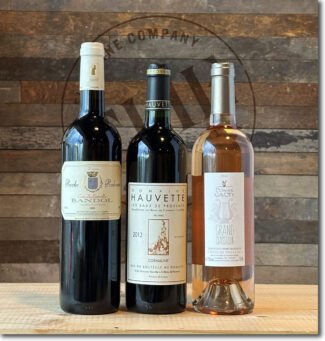
Bandol, Domaine Roche Redonne ‘Cuvée Les Bartavelles’ 2019 red ($69)
95% Mourvèdre and 5% Grenache; the wine’s cuvée name honors the local rock partridges. The vines average 40 years old; the youngest are 20 years and the oldest, 60. The yields are very low and the steep-hilled vineyards can only be harvested by hand. The wine shows boysenberry, blackcurrant, pepper and graphite shored up with well-integrated tannin.
Les Baux de Provence, Domaine Hauvette ‘Cornaline’ 2012 red ($41)
Cuvée Cornaline is a plush blend of 50% Grenache, 30% Syrah and 20% Cabernet Sauvignon farmed biodynamically on cretaceous limestone terroir. Grenache brings fresh strawberry and thyme to the profile, Syrah, black pepper and olive while Cabernet Sauvignon gives its black currant, tobacco and a light, enjoyable smokiness.
Côtes-de-Provence, Domaine Gavoty ‘Grand Classique’ 2022 rosé ($27)
Made of Grenache and Cinsault in roughly equal proportions. Rather than being pressed immediately after harvest as many Provence rosés are, Grand Classique macerates for several hours before pressing, and the saignée and first-press juice are vinified separately. The resulting wine shows strawberry and watermelon electrified by racy acidity.
The Languedoc
The Mediterranean Sea takes a sizeable chunk out of France’s hindquarters, and the bite-shaped crescent contains a few of the most dynamic winegrowing regions in the country. Clockwise, from just north of Spain, Languedoc is a swarthy appellation known for Grenache and Carignan blends—two varieties that love the hot coastal sunshine. Often joined at the hip with neighboring Roussillon, the insanely productive AOP accounts for more than a third of the country’s wine output. Historically, this wine was copious, inexpensive and rather forgettable—everyday wine for the tables of ordinary people. Since the mid-twentieth century, however, with the advent of irrigation in the foothills and coastal plains of Southern France coupled with improved techniques, the region now boasts fewer vines that produce wines of increasing quality.
A jigsaw of soils and a broad swath of microclimates creates ideal terroir for the warm-weather, full-bodied varietals often associated with the Rhône, while sharp diurnal shifts allow for the preservation of aroma and natural acidity, resulting in wines of extraordinary balance. A further plus is that Languedoc-Roussillon’s hot, dry climate discourages the growth of mildew and fungi, making synthetic pesticides and herbicides less necessary. As such, it has become a proving ground for organic and biodynamic producers.
$119 Red Languedoc Trio: Faugères, Terrasses-du-Larzac, Languedoc-Hérault
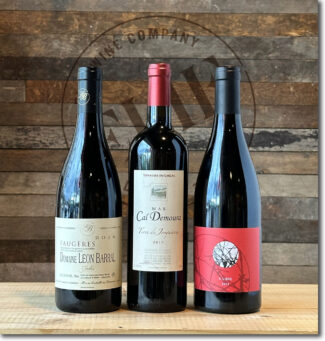
Faugères, Domaine Léon Barral ‘Jadis’ 2016 red ($47)
‘Jadis’ roughly translates as ‘long ago’ or ‘in olden days’—a wistful glance at the traditional way of doing things. Old vine Carignan and Syrah from the domain’s southern-facing vineyards, the wine offers exotic layers of musk, sour cherries and herbs with a mineral and saline finish.
Terrasses-du-Larzac, Mas Cal Demoura ‘Terre de Jonquières’ 2017 red ($32)
30% Syrah, 25% Carignan, 20% Cinsault, 15% Mourvèdre and 10% Grenache, with each variety vinified separately. The initial fermentation occurs in temperature-controlled stainless steel vats, after which the wines are racked into barrels and, after one year of aging, blended. The wine is given an extra six months of aging before being bottled without fining or filtration. The wine offers black fruit, licorice, and garrigue and remains elegant and fresh on the palate.
VdF Languedoc-Hérault, Clos de la Barthassade ‘K Libre – Carignan’ 2019 red ($40)
50% whole cluster Carignan and 24 months élevage in demi-muid and concrete egg produces a wine with an amazing array of spices on the nose; potpourri, Asian spices and sandalwood with a bright mineral overtone and a touch of smokiness. The palate is driven by fruit, especially raspberry.
The Roussillon
Author Jon Bonné refers to the sweet, fortified, Grenache-based wines of Banyuls as ‘Port that isn’t trying too hard.’ Likewise the Muscat-based wines of Rivesaltes, just to the north, whose fully oxidized, dry wines native come across like France’s response to Sherry.
But the real interest in today’s world is dry, intensely mineral red and white wines being made there these days; a factor that may be confused when Roussillon’s best dry wines are lumped in with Languedoc to the north, doing a disservice to both appellations. Roussillon’s current focus is clear: Acid-driven wines that are unquestionably southern, but also subtle, as winemakers have found a way to modulate the sun. In part this involves impeccable, often organic farming to make wines whose complexity rivals top Rhônes.
Roussillon’s affordable land also makes it a magnet for a lot of natural-wine pioneers including naturalist icons like Edouard Laffitte of Le Bout du Monde, whose easygoing wines mirror those of several like-minded vignerons and prompted their village of Lansac to be dubbed Jajakistan—an in-joke derived from French slang for gluggable wine.
$104 Red Roussillon Trio: Collioure, Maury, Corbières
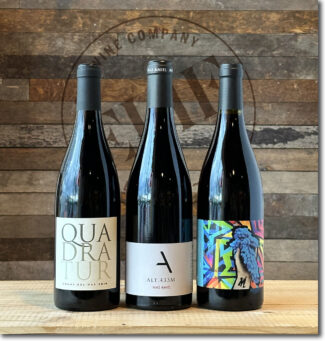
Collioure, Coume del Mas ‘Quadratur’ 2016 red ($37)
50% Grenache Noir, 30% Mourvèdre and 20% Carignan from high-altitude old vines with concentrated, low yield fruit. In the winery, strict hand and table sorting precedes a long maceration and fermentation intended to extract maximum flavor, followed by 12-14 months in oak barrels before bottling without filtration. The wine showcases delicious notes of dark fruits, spices, wild herbs and earth.
Maury, Mas Amiel ‘Alt.433m’ 2017 red ($36)
The plot for this wine was planted in 1962 with Grenache and Lladoner Pelut vines at an altitude of 433 meters—hence, the name. Lladoner Pelut is a natural mutation of Grenache which reaches phenolic ripeness sooner and produces wines with a lower alcohol content; it is more commonly used in the wines of Priorat, Catalunya. It offers delicate notes of crushed stone, cranberries and fresh herbs in a silky package with hints of orange zest and rose hips.
VdF Roussillon-Corbières, Domaine Yohann Moreno ‘GS’ 2021 red ($31)
A fun, ‘glou-glou’ style of light Grenache and Syrah; a crunchy core of candied blueberry is offset by a bit of minerality.
Corsica
Corsica has been described as penumbral Italy and Sardinia’s French twin, although in fact, it is very much a wine-producing appellation with its own native soul. Corsicans are imbued with a vehement sense of pride and independence, born in part from perpetual watchfulness: As winemaker Christian Giacometti shares, “The reason our villages were never near the sea is that the Corsicans were always fending off invaders.”
Corsican vignerons work with a roster of seemingly unpronounceable varieties like Sciaccarellu, Biancone and Paga Debiti. In the past couple of decades, these sumptuous, spicy wines have found a growing patronage among those of us in the west eager to learn more about a peripheral Mediterranean gem and these island wines, created without France’s intellectualism or Italy’s numbing regulations and crowd-pleasing varieties, opting instead for face-value frankness and above all, native grapes.
$117 Red & White Corsica Trio: Patrimonio, Corse Figari
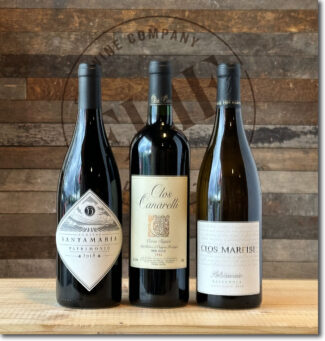
Patrimonio, Domaine Santamaria 2018 red ($37)
100% Nielluciu from 25-year-old biodynamic vines grown in a microclimate meliorated by the Ligurian Sea, where soils are (unlike much of Corsica) largely composed of chalky clays and limestone. The grapes are hand-picked and fermented on native yeast, then bottled without fining. Patrimonio is the first AOP in France to forbid chemical weeding; the wine shows cranberry and raspberry with a touch of earthy minerality and spice.
Corse Figari, Clos Canarelli 2016 red ($45)
The soils of the Figari AOP make up France’s southernmost wine region, and it is maintained by many that this bottling represents the best profile of the Sciaccarellu grape to be found. The bright sunshine and granite soils of the southwest part of the island are a perfect cradle for the grape and the wine shows it’s characteristic herbal spice behind soft berry notes and easy tannins.
Patrimonio, Clos Marfisi ‘Ravagnola’ 2020 white ($35)
Vermentino (known in Corsica as Vermentinu) shows off its island expression as floral, with bright flashes of citrus and an almost salty finish, quite reflective of the clay, chalk and schist soils less than a mile from the sea.
A Gift That Keeps On Giving
Membership To ‘The Champagne Society’
Bimonthly Subscription
 Not only is Champagne the quintessential drink of celebration, it has traditionally been a gift given with ramped-up sentiments. This year we are offering a couple of variations on this theme, beginning with an opportunity to gift a special someone a six-month or twelve-month membership to The Champagne Society. Our pick for December will be packaged in a wrap-ready gift box along with a congratulatory certificate explaining what lies ahead in bi-monthly installments. For more information please visit our website page: A Holiday Gift: ‘The Champagne Society’ Membership 6-Month ($299) or 12-Month ($589) Subscription.
Not only is Champagne the quintessential drink of celebration, it has traditionally been a gift given with ramped-up sentiments. This year we are offering a couple of variations on this theme, beginning with an opportunity to gift a special someone a six-month or twelve-month membership to The Champagne Society. Our pick for December will be packaged in a wrap-ready gift box along with a congratulatory certificate explaining what lies ahead in bi-monthly installments. For more information please visit our website page: A Holiday Gift: ‘The Champagne Society’ Membership 6-Month ($299) or 12-Month ($589) Subscription.
Elie
- - -
Posted on 2023.12.15 in France, Wine-Aid Packages | Read more...
Burgundy’s Wealth Of Riches: Shopping List Of Thirteen Packages Of Red ‘Premier-Cru vs. Village’ Pairs To Gift Wine Lovers, Or Explore. Thirteen Intrepid Producers In Thirteen Côte-d’Or Communes.
We can accept that each plot of land on earth is handed a certain microclimate, and whereas climate change may alter some aspects of its character, an acre’s terroir is written in stone… and soil, and elevation, and exposure. But it is very much a human endeavor to make the most of every hand we are dealt, and as such, although the complex and highly-specific Burgundian classification system rarely offers upgrades for loyal service, the efforts of winemakers, combined with changing weather patterns, often raises the bar in areas deemed Village-level rather than Premier Cru to create wines that are superlative.
In this week’s overview, we will take a look at the similarities and differences in a few familiar names when they set their mind to producing a bottling from various hallowed plots of Burgundian territory, both Village-designated and those that wear the Premier Cru label.
Take advantage of these Holiday Packages to explore and discover; treat yourself to a unique opportunity to try several of these appellations—Village level and Premier Cru level—side by side, or gift an example to a wine-lover among your circle of friends and family.
The Notion Of Terroir: Earth Is Given Voice
Above all, terroir is a concept; a flight of vinous fancy that insists a wine’s taste and aroma reflect its place of origin. This reflection may be subtle or overt, but there’s plenty of science behind it. Terroir includes specific soil types, topography, microclimate, landscape characteristics and biodiversity—all features that interact with a winemaker’s choice of viticultural and enological techniques.
Every square foot of earth that supports a vine has its own unique terroir, and wine appreciation is founded on the principal that not all terroirs are created equal. Thus, we find the hyper-division of vineyards sites from the most broad to the narrowest—some named climats are only a few rows in size, but produce wine markedly different than their neighbors. In Burgundy, this obsession with small, precisely delimited parcels is probably more defined than anywhere else, and we will always seek out the best of those wines and share as much information about the vineyards as we can unearth… pun intended.
Decoding The Burgundy Hierarchy
Nowhere does terroir count more blatantly than in Burgundy’s classification system, which has four distinct levels, Grand Cru, Premier Cru, Villages and Régionale, divided up into 84 separate appellations.
Grand Cru, the top of the pyramid, represent less than 1% of the region’s total production. All of the white Grand Crus are today found in the Côte de Beaune, while all of the red Grand Crus (with the exception of the Corton family) are found in the Côte de Nuits. To be consistently exceptional requires exceptional strictures; besides being the favored sites geographically, Grand Cru wines are made with a specified grape variety from a regulated patch of land, from vines of at least 3 years of age and below a certain maximum yield per unit area of land.
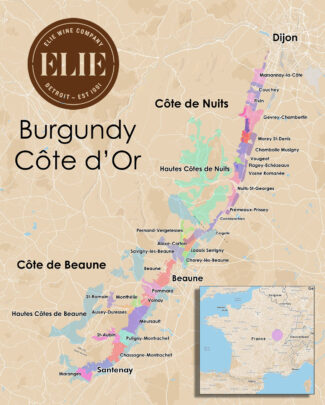
Premier Cru wines account for another 5% of Burgundy’s total production, and as such, is only a slightly larger drop in the bucket. There are a few that may outperform Grand Cru wines, but they are priced accordingly. The majority of Premier Crus are from named vineyards, and the climat name will appear on the label. For example, Puligny-Montrachet Premier Cru Les Folatières assures you that this wine comes from the Folatières vineyard in the village of Puligny-Montrachet.
Village level wine is a broad and encompassing swath of terroir recognition, but it is undeniably describable: Savigny is meaty, Volnay is elegant, Vosne-Romanée is spicy, Meursault is nutty. Wines at this level have a slightly higher allowed yield per hectare, but the varietal requirements are the same. This is a slot where Burgundy’s best bargains fit; any vineyard site, Grand Cru or Premier Cru can go into a bottle labeled only after a village. Although it might sound counter-intuitive for a domain to do this, it isn’t. Wineries declassify Grand Cru and Premier Cru wines frequently, and for a variety of reasons.
Régionale wines represent the bulk of wine produced in Burgundy; they are generic, have much more relaxed standards for yields and grape types. They may be labeled Bourgogne Rouge, Bourgogne Blanc, Bourgogne Pinot Noir, Bourgogne Chardonnay or Bourgogne Aligoté—even Bourgogne Passtoutgrains, which is Gamay mixed with a lower percentage of Pinot Noir.
Côte de Beaune
A Myriad Of Soils And Microclimates
A mnemonic device for remembering which shade of wine is best represented by the two subdivisions of the Côte d’Or, the Côte de Beaune and the Côte de Nuit: Bones are white, and the greatest of the Chardonnay-based white Burgundy (Corton-Charlemagne, Montrachet, et al) are from Beaune. Night is dark, and the greatest Pinot Noir-based reds (La Romanée-Conti, Chambertin, et al) come from the ‘Night Slopes’—the Côte de Nuit.
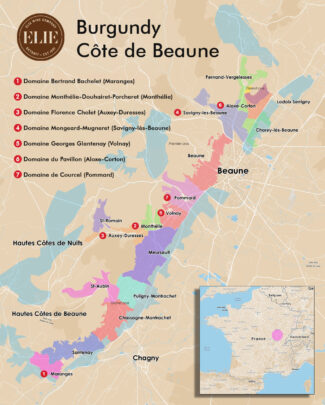
Of course, the two regions make wines of either color. The Côte de Beaune is the southern half of the Côte d’Or escarpment, hilly country where, like the bowls of porridge in Goldilocks, the topsoils near the tops of the elevation are too sparse to support vines and, in the valleys, too fertile to produce top quality wine. The Goldilocks Zone (the mid-slopes) are where the Grand and Premier Cru vineyards are found, primarily at elevations between 720 and 980 feet. Drainage is good, and when vines are properly located to maximize sun exposure, the greatest Burgundies thrive and produce, year after year. The lesser, often forgettable Burgundies (generic Bourgogne) comes from the flatlands beneath the slopes; the fact that these wines are also made from Pinot Noir and Chardonnay is indication of why terroir matters. Likewise, the narrow band of regional appellation vineyards at the top of the slopes produce light wines labeled Bourgogne Hautes-Côtes de Beaune.
$91 Maranges Village vs. Premier Cru
f the name ‘Maranges’ (at the southern tip of the Côte de Beaune) strikes you as unfamiliar, it’s understandable: It has only existed as a stand-alone appellation since 1988 and encompasses the three villages of Cheilly-lès-Maranges, Dezize-lès-Maranges and Sampigny-lès-Maranges, just west of the more well-known village of Santenay. It is situated in storybook countryside referred to by Burgundian writer Henri Vincenot as ‘gentle and warm-hearted, where the old-fashioned homes of the winemakers provide perfect subjects for a painter’s brush.’
Unlike much of the Côte de Beaune, the slopes of Maranges have a southerly to south-west exposure, although the make-up of the soil is nearly identical. Cheilly, in the valley of the Cozanne, has rather light pebbly soils while the climats of Sampigny and Dezize to the south of Santenay lie on brown limestone soils and limey marls. A handful of these are classified as Premier Cru, including Clos de la Boutière, Clos de la Fussière, La Fussière, Le Clos des Loyères, Le Clos des Rois, Le Croix Moines and Les Clos Roussots. Peppering these prime spots are numerous lieux-dits.
In general, the production is red, but Chardonnay plantings are on the upswing. The reds are fruit-laden and show blackcurrant and spiced—even preserved—red fruits, often tinged with licorice. The whites, still somewhat rare, offer hawthorn, acacia and honeysuckle when young, and with age, showcase notes of gunflint and honey.
Domaine Bertrand Bachelet
Fourth generation in a line of Burgundy winegrowers, Bertrand took over from his father Jean-Louis in 2012, working 32 acres stretching from Maranges to Pommard. The estate itself is located in Dezize-lès-Maranges, which accounts for the greatest percentage of Bachelet’s production.
“I have always been passionate about our family tradition of producing high-quality wines, but I have opted to employ new techniques that come from modern viticulture and oenology, all with an aim of drawing the best from each terroir. My foremost emphasis is on the meticulous work in the vineyard required to grow healthy grapes. From the pruning stage right up to the harvest, all work is done manually.”
He adds that vinification is still carried out in a traditional manner with little intervention, to highlight the uniqueness and complexity of the region.
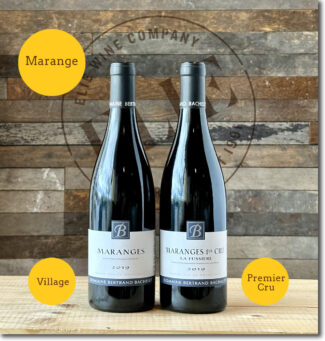 Domaine Bertrand Bachelet, 2019 Maranges ($41)
Domaine Bertrand Bachelet, 2019 Maranges ($41)
Bechelet’s Village-level wine comes from two localities, Aux Artaux and En Crevèches, both situated in the Cheilly-lès-Maranges area. Bertrand considers this a wine to reach its peak within a few years of harvest; it is particularly aromatic, with a nose reflecting raspberries, blackcurrants and candied cherries.
Domaine Bertrand Bachelet, 2019 Maranges Premier Cru La Fussière ($50)
Located in the Cheilly and Dezize-lès-Maranges, La Fussière is the main climat of the Maranges appellation. It is planted 100% to Pinot Noir on clay, marl and limestone rocks. The grapes for this wine are rigorously sorted before being partially or totally destemmed; vatting lasts for about three weeks, with regular temperature controls. Extractions are done with very little intervention beyond pigéage and rémontage. The wine is aged for one year followed by several months in vats to stabilize the wine before bottling. The concentration of 50-year-old vines is evident in the wine’s refined texture and sustained finish where notes of black tea and fresh leather mingle with black cherry, wild raspberry and currant.
$115 Monthélie Village vs. Premier Cru
Author Pierre Poupon describes Monthélie as being “…prettily nestled into the curve of the hillside like the head of Saint John against the shoulder of Jesus. Monthélie resembles a village in Tuscany.”
The appellation is home to 15 Premier Cru climats concentrated in one area to the east of the village, bordering the more prestigious vineyards of Volnay. A rose is a rose, but not all Premier Cru sites are created equal, and traditionally, those of Monthélie are not considered among Burgundy’s finest. Classic Monthélie wines are similar to those of neighboring Volnay (the villages are only a mile apart) but are not quite as full flavored or elegant, but they are generally considered to be superior to the red wines of Auxey-Duresses, also just a mile away in the other direction. Again, these are ideal terroirs to stir in a little extra warmth via global warming and follow the improvements with a corkscrew and glass.
Domaine Monthélie-Douhairet-Porcheret
The triumvirate of names each has its own special significance to the estate. Named first for the 300-year-old southern Burgundy village in which it is located, Monthélie-Douhairet was run by the Douhairet family for many years. In the early 1970s, the two sisters Armande and Charlotte Douhairet inherited the vines and decided to separate; Armande fought to keep her share while Charlotte sold hers. Then, in 1989, Madame Douhairet asked renowned winemaker André Porcheret to take charge and subsequently, added his name to the domain.
André Porcheret has been one of the great figures in Beaune; prior to overseeing Domaine Monthélie-Douhairet he was the cellar manager at the Hospices de Beaune, then worked for Lalou Bize Leroy to make wines at the newly created Domaine Leroy—whereupon, he returned to the Hospices de Beaune for another five-year stint. Today, with his granddaughter Cataldina Lippo, he produces wines on M-D-P’s fifteen acres that are classic, elegant and true to the terroirs of Pommard, Volnay, Meursault and Monthélie.
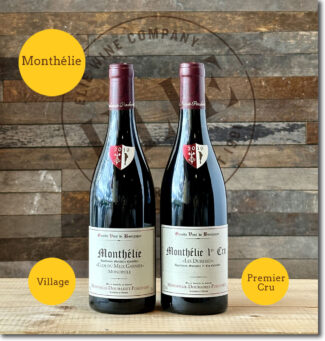 Domaine Monthélie-Douhairet-Porcheret, 2019 Monthélie ‘Clos du Meix Garnier’ Monopole ($46)
Domaine Monthélie-Douhairet-Porcheret, 2019 Monthélie ‘Clos du Meix Garnier’ Monopole ($46)
‘Clos du Meix Garnier’ is a vineyard entirely owned by the estate—making it a monopole. From these three acres, about 8000 bottles are produced annually; the grapes are 100% de-stemmed and treated to gentle, old school fermentation and maceration before being aged for 18 months in barrels (10% new). Aromas of blood orange, raspberries and plums introduce a satiny wine with tangy acids and chalky tannins.
Domaine Monthélie-Douhairet-Porcheret, 2019 Monthélie Premier Cru Les Duresses ($69)
The 16 acres of Les Duresses is the only Premier Cru vineyard on the western side of Monthélie between Volnay and Meursault. Les Duresses is planted to 82% Pinot Noir, although there is some Chardonnay on the upper slope. Soils are pebbly marl with a good proportion of clay, especially lower down the slope. Argovian (Jurassic) limestone provides the minerality for which these wines are famous. The wine displays a depth a similar depth to the Meix Garnier, but is fruitier, like ‘Miss Armande’. There is more muscle, too, with raspberry and strawberry notes showing above slight oak and leading to a lengthy finish.
$129 Auxey-Duresses Village vs. Premier Cru
There was a time when the wines of Auxey-Duresses were sold under false premises—the reds were named Volnay and the whites, Meursault. In fact, experts could easily tell the difference. Yet, the differences have begun to evaporate as a new generation of winemaker in the appellation, coupled with a changing climate, has realized that Auxey-Duresses grapes may have the breeding to rival their hallowed neighbors without the need of fraud.
The first obstacle they had to overcome was geography. Unlike Meursault and Volnay, Auxey-Duresses vines cling to a variety of high slopes and have traditionally produced a hard red wine that is frequently sold to négociants for Bourgogne Rouge blends. But with patience, these same grapes, when bottled at estates within the appellation, improve immeasurably and become silken gems that may rival nearby powerhouses at a fraction of the cost.
Likewise Auxey-Duresses whites that may initially produce the hazelnut whiffs familiar to fans of Meursault, are beginning to produce wines of increasing depth that improve exponentially in the cellar. The warmer weather has been a godsend to intrepid vignerons who have raised the value of Auxey-Duresses far beyond its current price tag.
Domaine Florence Cholet
The Platonic idea of this package’s theme may be Domaine Florence Cholet, an estate formed Florence’s father Christian in 1976 (as Domaine Christian Cholet-Pelletier) who was joined in 1982 by his wife Anne. Located in the tiny village of Corcelles-les-Arts east of Puligny Montrachet and directly across from Meursault, the 18.5 acres of marl and limestone are planted to 75% Chardonnay and 25% Pinot Noir; vines range from 25 to 75 years old and the estate bottles about 1400 cases per year.
Having gained work experience across France (Chapoutier), the United States (Walla Wall, Washington) and Australia, daughter Florence studied biology and biochemistry at the University of Burgundy in Dijon where she earned a license in viticulture and a Master’s degree in oenology. In 2019, she returned to Corcelles-les-Arts to take over the estate from her parents, renaming it Domaine Florence Cholet. Among the innovations she brings to the domain is a policy against herbicide and pesticide; she ploughs by horse and allows natural fermentation on native yeasts. New oak is used sparingly at a maximum of 25% and wines are bottled using only a minimum of filtration.
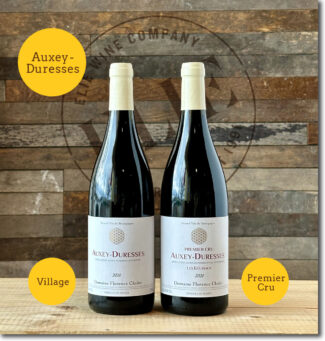 Domaine Florence Cholet, 2020 Auxey-Duresses ($61)
Domaine Florence Cholet, 2020 Auxey-Duresses ($61)
From 60-year-old vines grown between Meursault and Monthélie; Cholet’s penchant for gentle pressing and prolonged fermentation makes this a modern-style Burgundy filled with freshness and perfume. On the palate, there is cranberry crunch with wild strawberries and a touch of dried herb.
Domaine Florence Cholet, 2020 Auxey-Duresses Premier Cru Les Ecussaux ($71)
Les Ecussaux is a Premier Cru vineyard on the Montagne du Bourdon, just to the east of the Auxey-Duresses village, between the roads to Beaune and to Meursault, whose junction forms its most westerly point. To the north lie the Premier Crus Les Duresses and Bas des Duresses. The wine displays firm tannins, crisp blackberry and mulberry, a touch of white pepper and a fleshy finish.
$130 Savigny-lès-Beaune Village vs Premier Cru
Chances are, you love wines from the Rhine and are passionate about wines from the Rhône, but at first glance, ‘wines of the Rhoin’ may look like a typo. In fact, this small river flows from the cliffs of Bouilland through the commune of Savigny-lès-Beaune, and alluvia from the overflow adds fertility to the lower slopes of the hills of Beaune. With nearly nine hundred acres of vineyard, the appellation is one of Burgundy’s largest.
Savigny’s terroir features a gentle gradient that becomes steeper as the altitudes approach 1300 feet, where the geology is similar to that of the great Grand Cru hill of Corton. Favored exposures face the south, where the soils are gravelly and scattered with oolitic ironstone. Near the river valley, the red-brown limestone becomes more clayey and pebbly, while the east-facing slopes consist of sand and limestone.
As rich in history as it is in Premier Cru vineyards (there are 22), Savigny-lès-Beaune was once a social hub where the nobility and clergy rubbed shoulders, and the near mythical regard for the quality of its wine is reflected in a stone carving on a Savigny château: “The wines of Savigny are nourishing, theological and keep death at bay.”
Domaine Mongeard-Mugneret
The name ‘Mongeard’ first makes an appearance in Burgundy in 1786, where records show a Mongeard working as vigneron for Domaine de la Romanée-Conti. Skip forward to 1945, when at the age of 16, Jean Mongeard (whose mother was from Famille Mugneret) made wine which he sold by the barrel to négociants. The entire 1945 crop was purchased by Baron le Roy, Marquis D’Angerville, and Henri Gouges, who suggested that the young Mongeard start bottling the wines himself.
In 1975, Jean’s son Vincent began working alongside his father and became responsible for viticulture and vinification of the domaine’s wines. He persuaded his father to return to the traditional method of bottling without filtration and filtering only in certain vintages. Upon his retirement in 1995, Vincent assumed complete leadership of the domain, which now covers more than 75 acres split among 35 appellations.
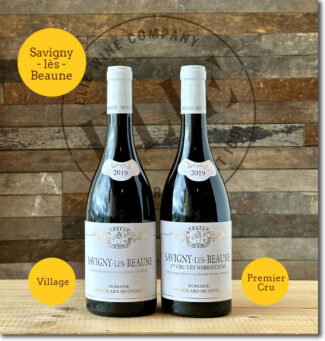 Domaine Mongeard-Mugneret, 2019 Savigny-lès-Beaune ($58)
Domaine Mongeard-Mugneret, 2019 Savigny-lès-Beaune ($58)
From vines with an average age of 36 years, the wine sees around 15% new oak. Youthful and intense, this brilliant ruby-colored Pinot displays characteristic aromas of spice and violet mingled with wild blackberry; nice length and elegance.
Domaine Mongeard-Mugneret , 2019 Savigny-lès-Beaune Premier Cru Les Narbantons ($72)
From their 8.4-acre parcel in Les Narbantons, Vincent Mongeard drew from vines more than a half century old, hand harvesting and sorting the grapes, then aging the wine in 30% new oak. The wine shows a deep and complex bouquet of cassis, fresh wild berries, wood smoke, cola with some hazelnuts and citrus rind. A muscular mouthful, it’s layered with powdery tannins, lively acids and a long, sapid finish.
$153 Volnay Village vs. Premier Cru
No red wine appellation is more synonymous with ‘perfume’ than Volnay; the wines have historically checked all the boxes for quality, vigor and longevity but with an aromatic delicacy traditionally referred to as ‘feminine.’ The appellation has existed since 1937, and is reserved for Pinot Noir-based red wines exclusively. Although the region contains no Grand Crus, more than half of the vineyards covered by Volnay’s 526 acres are rated as Volnay Premier Crus. Just across the boundary that delimits Meursault, Volnay-Santenots is grown on terroir better suited to Pinot Noir than Meursault’s legendary Chardonnay.
The appellation stretches across a narrow band of oolitic limestone on the hill of Chaignot, with vineyards facing south-east. At the top of the slope, the soil is pink in color with pale green inclusions overlain by schist. As the ground descends, white, chalky-textured argovien limestone takes over, with a third layer of reddish Bathonien limestone finally giving way to deep gravel soils at the foot of Chaignot.
These varied soils combine to give relatively small Volnay a remarkable number of recognized lieux-dits (24) and climats classified as Premier Cru (34), each unique in expression, but yoked by an inimitable Volnay style: Spicy fragrance, elegant structure and silken mouthfeel, qualities that transcend producers, both of the traditional old guard and the innovative new.
Domaine Georges Glantenay
With 27 acres of vineyards in Volnay, Pommard, Meursault, Monthélie and Chambolle-Musigny, Domaine Georges Glantenay is the result of five generations of winegrowers passing along land and artistry from father to son.
Currently, 27-year-old Guillaume is in charge of viticulture and winemaking, while his sister Sarah is an ambassador for the estate. Guillaume describes his philosophy this way: “We practice lutte raisonnée, involving ploughing without the use of pesticides or herbicides. In the cellar, our grapes are almost all destemmed, then given a short cool maceration, following which fermentation occurs using natural yeasts. Extraction mainly consists of pumping over, with a little punching-down. Our Premier Cru sees 30% new oak on average, our Village wines 20%. Most of our production is red and we focus on wines with silky tannins are the key here, making for elegant, refined wines which are also age-worthy.
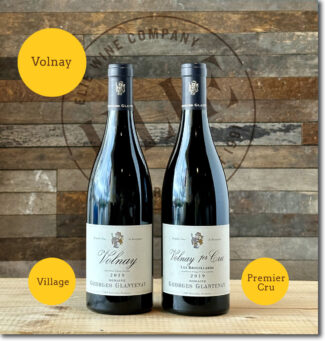 Domaine Georges, 2019 Glantenay Volnay ($54)
Domaine Georges, 2019 Glantenay Volnay ($54)
This Village-designated assemblage comes from multiple plots covering the appellation from north to south and located just below the Premier Crus, including Les Aussy, Les Petits Gamets, La Gigotte, Les Buttes, Robardelles, Les Grands Poisots, En Echards and Les Combes. Ripe raspberry and candied violet on the nose; a crisp and bracing wine styled as a fully modern Volnay, from bouquet to the fresh, crunchy finish.
Domaine Georges Glantenay, 2019 Volnay Premier Cru Les Brouillards ($99)
Brouillards is the domain’s flagship wine, and their largest Premier Cru holding. It is on the Pommard side of the village, to the north of Mitans and across the road from Les Angles. With about 25% whole-bunch fermentation, most of the vines date to 1950 (2 acres) and 1999 (3/4 acre). The wine is delineated and focused, and shows vibrant raspberry, black plum, sous-bois and a hint of allspice in a peppery finish.
$192 Aloxe-Corton Village vs. Premier Cru
The appellation of Aloxe-Corton stands guard near vinous gates of the Grand Crus of Corton and Corton-Charlemagne, enjoying (if not the prestige) many similar growing conditions, producing almost exclusively red wines known for both a depth of color and an intensity of flavor. With vines facing east, the terroir is soil driven, with flint and limestone rich in potassium and phosphoric acid lending supple firmness to the wines, especially those from the appellation’s southern end.
Whereas white wines from the region exist, they are rare. The deep soils are better suited for Pinot Noir; the terroir is a geological cradle for this prima donna varietal. At altitudes averaging 800, the vineyards are planted in reddish earth with flint and limestone debris known locally as ‘chaillots’ mixed in, and likewise rich in potassium and phosphoric acid. Such soils favors supple, highly-bred wines, while clay and marl breeds firmness and complexity. Anticipate wild berry notes that intensify with age and evolve into peony and jasmine, brandied fruits, pistachio, prune and truffle.
Domaine du Pavillon
Located south of Pommard, the Côte de Beaune’s Domaine du Pavillon is under the umbrella of the Bichot family, who settled in Burgundy in 1350. Albéric Bichot took over management in 1996, and although he fully respects traditions, he remains focused on the future, comparing himself to the ‘conductor of an orchestra, proud to bring people and their talents together over a common project.’
Among the talented people he has brought together is head winemaker Matthieu Mangenot who brings to Beaune a wealth of experience from estates in South Africa, Lebanon and Bordeaux. After his first experience in the Mâconnais/Beaujolais region, he joined Albert Bichot in 2007 as manager of Domaine Long-Depaquit in Chablis. His dual training as an agronomist and an oenologist allows him a comprehensive approach to winemaking, from vineyard management to bottling. His knowledge of soil formations and his pragmatic, transversal approach benefit the development of the House’s productions and pair well with its concern for authenticity and sustainability. “The wines of the Pavillon will bear the certified ‘organic wine’ label starting with vintage 2018,” he promises.
Viticulture is handled by Christophe Chauvel, assisted by Dominique Bon. Chauvel arrived in Burgundy in 1982 to study at Beaune’s viticultural secondary school, and after gaining experience under Sommelier Jean-Luc Pouteau at the restaurant Pavillon Elysée Lenôtre in Paris, he decided to go back to school to follow a 4-year winemaking program in Bordeaux. He joined the Albert Bichot estates in 1999.
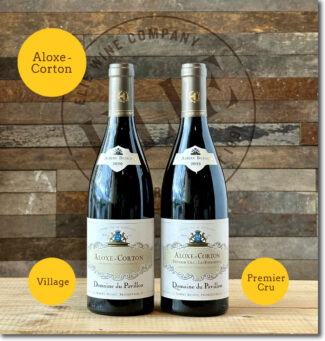 Domaine du Pavillon, 2020 Aloxe-Corton ($82)
Domaine du Pavillon, 2020 Aloxe-Corton ($82)
From the south end of Aloxe-Corton; the unlovely-sounding ‘Crapousuets’ is actually a one-acre lieu-dit that produces deeply serious Pinot Noir: This one shows a dark, ferrous nose with spiced cherry and cassis notes behind sweet damson and ripe, soft tannins. Only 3000 bottles made.
Domaine du Pavillon, 2020 Aloxe-Corton Premier Cru Fournières ($110)
From a one-acre plot on the eastern fringe of Aloxe-Corton at the base of the Corton hill, with some vines creeping up the lower slope. These 40-year-old vines are planted on scree overlying limestone. The name comes from the practice of clearing parcels by a burn-out process in stoves where the dried clods of kindling are called ‘fournières.’ The wine offers up a vibrant nose of ripe cherries and quintessential Corton spices with an appropriate touch of bonfire and supple tannins.
$288 Pommard Village vs. Premier Cru
The Pommard appellation covers only red wine, and as such, its renown is based on the lusciously ripe, deeply intense richness that Pinot Noir seems only able to achieve in Burgundy. With primarily mid-slope vineyards, Pommard boasts 28 Premier Crus which run almost uninterrupted from the commune boundaries of Beaune in the north to Volnay in the south. In fact, the only break in this belt of prized mid-slope vineyards is provided by the streets and houses of Pommard village itself.
Pommard’s terroir is somewhat typical of Burgundian red wine country. At the lower elevations, the soil is ancient alluvium, while mid-slope, the clay-limestone soils are well drained thanks to the inclusion of rock debris. Higher up are Jurassic (Oxfordian) marls, brown calcic soils, and brown limestone soils where in places, the soil is reddened by the presence of iron. Of the roughly 850 acres of vineyard, roughly one-third are Premier Cru, of which the most famous are Les Rugiens and Les Épenots.
Domaine de Courcel
Essentially built around Premier Cru sites, de Courcel’s 26 acres are peppered across Le Grand Clos des Épenots, Les Rugiens, Les Frémiers and Les Croix Noires. Le Grand Clos des Épenots, which accounts for 50% of the Domaine’s production, and Les Rugiens, are in a climat class of their own. The estate is currently managed by Gilles de Courcel, Anne Bommelaer and Marie de Courcel.
Marie is justifiably proud both of her family’s place in Burgundian history and the estate’s commitment to terroir and ecology: “We plough in such a way as to encourage intense biological activity, enabling the vines to better assimilate the minerals contained within the soil. The ploughing also helps the root of the vine penetrate deeper into the ground for a better expression. We optimize ripeness by pruning techniques, including de-budding and green harvesting in early August. We are after a delicate equilibrium in the fruit, and our final harvest is done relatively late so that the September sunshine increases the sugar intensity.”
Yves Confuron, de Courcel’s winemaker has always worked organically, believing that anything else would not be true to the expression of the site. Far from being a nod to the current fashion of biodynamics, it is an understanding each site must be treated naturally and maintained immaculately in order to wrest everything that it has to offer in a given vintage. He argues. “You cannot do this by picking anything but fruit as ripe as the vintage can make it, and that the whole bunches must go into the vat because that is all part of the origin.”
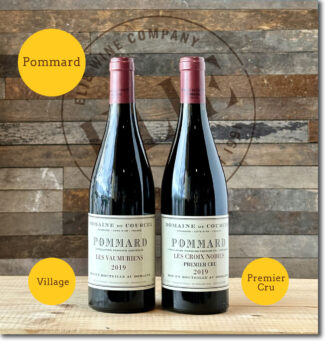 Domaine de Courcel, 2019 Pommard ‘Les Vaumuriens’ ($135)
Domaine de Courcel, 2019 Pommard ‘Les Vaumuriens’ ($135)
Pinot Noir from forty-year-old vines grown organically and planted on a 3.5-acre Village-level lieu-dit plot above the Premier Cru Les Rugiens. Vinification is done with whole bunches and cold maceration, and 21 months maturation in oak barrels, a third of which are new. Neither fined nor filtered. The wine shows rich black tea notes and herbs behind the dominant blackberry and black cherry profile.
Domaine de Courcel, 2019 Pommard Premier Cru Les Croix Noires ($153)
Les Croix Noires (‘The Black Crosses’) is a small Premier Cru vineyard entirely surrounded by other Premier Cru vineyards—Les Chaponnières lies on the slope above and to the west; Les Poutures and Les Bertins lie below and Les Frémiers to the south. Domaine de Courcel owns about half of it. Ripe red berries are in the forefront of this silken wine, shored up by warm earth and background nuances of humus and sweet flowers before concluding in a dusty, firmly structured finale.
Côte de Nuits
Terroir Lives Here
Named after its principal town, Nuits-St-Georges, the Côtes de Nuits produces the greatest red wines of Burgundy. As in its counterpart, the Côte de Beaune, not all the wines are created equal; the best are from a narrow, mid-slope band of limestone and from vineyards facing south-east to maximize exposure to the sun. This precise mix of soil and sunshine allows Pinot Noir to showcase an extraordinary range of textures and flavors.
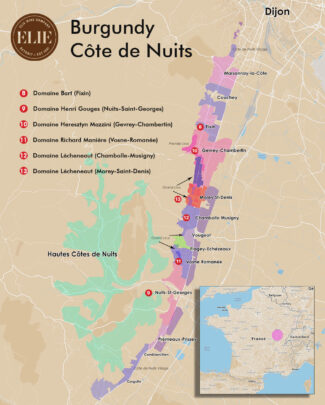
Côte de Nuits is subdivided into eight designated village; Chambolle-Musigny, Fixin, Gevrey-Chambertin, Marsannay (which also has a separate designation for rosé), Morey-Saint-Denis, Nuits-Saint-Georges, Vosne-Romanée and Vougeot. The area includes 24 superlative vineyard sites clustered around six communes and designated Grand Cru and over a hundred Premier Cru sites. In addition, there are two district appellations: Côte de Nuits-Villages, which are wonderfully elegant and affordable reds that are ready to drink upon release, and Bourgogne Hautes Côte de Nuits, which consists of some 20 villages in the hills west of the vineyards of the Côte de Nuits that produce wines with this appellation.
$198 Fixin Village vs. Premier Cru
Situated just north of Gevrey Chambertin—and often compared to it stylistically—Fixin is a small, predominantly Pinot Noir appellation whose wines are generally well-regarded. Along with its neighbor Marsannay, it is one of the most northerly appellations of the Côte de Nuits, covering roughly 250 acres of vineyards spread evenly between Fixin itself and its southern neighbor, Brochon.
There is a group of vineyards on the slopes immediately above Fixin where the terrain rises quite rapidly from 950 to 1150 feet, providing relatively steep, well-drained sites with the limestone-rich soils so characteristic of classic Burgundy. In this region, six Fixin Premier Cru sites are found, most of them located around the western side of Fixin village itself.
Domaine Bart
Sixteen years ago, the winegrowers of Marsannay started the process of having part of the appellation upgraded to Premier Cru. At Domaine Bart, which produces as many as nine different Marsannay bottlings in a given vintage, it is believed that 25% and 30% of the appellation is up for this bump upstairs. Pierre Bart, the sixth generation to run Domaine Bart, says, “We are trying to show which climats would be of interest and which ones should remain in the village appellation. My guess is that there will be five or six Premier Crus. probably the largest ones like Champs Perdrix, Champ Salomon, Clos du Roi, Longeroies and Montagne.”
The Bart domain covers 54 acres, mostly in Marsannay, but with a few parcels in Fixin, Gevrey-Chambertin, Chambolle-Musigny and Santenay.
“My grandmother comes from the same family as Domaine Bruno Clair,” explains Pierre Bart. “Part of the vines come from that side of the family, part from my grandfather’s side. The Bonnes-Mares and the Chambertin-Clos de Bèze mainly come from my grandmother. 35 years ago, when my uncle arrived at the domain, the style of the wines changed. He increased the size of the holding, mainly in Marsannay. He chose to improve quality, both in terms of equipment and in winemaking. Since then we haven’t changed our vision a single iota.”
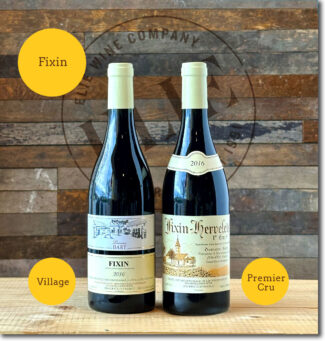 Domaine Bart, 2016 Fixin ($88)
Domaine Bart, 2016 Fixin ($88)
Dark raspberry, sour cherry and dried herbs and the characteristic woodsy ‘sous bois’ lift this wine which has found its stride after several years of impeccable bottle aging.
Domaine Bart, 2016 Fixin Premier Cru Hervelets ($110)
Among Fixin’s Premier Cru vineyards—Clos de la Perrière, Clos du Chapitre, Arvelets, Clos Napoléon, Le Meix Bas and Hervelets, Hervelets is known to produce heavier and longer-lived reds This one is spicy, revealing sandalwood, sweet baking spices and light pepper aromas framing cherry and raspberry, with a soft dusting of tannins on the finish.
$207 Nuits-Saint-Georges Village vs. Premier Cru
With the village of Nuits-St-Georges itself as the fulcrum, the robust appellation extends to the north as far as the border of Vosne-Romanée, while the southern section lies partly in Nuits-Saint-Georges and partly in Prémeaux. The wines from each section are unique in style and according to experts, with differences defined (in the main) by the lay of the land. The soils in the northern sector are built around the pebbly alluvium that washes down from up-slope, or in the low-lying parts, around silty deposits from the river Meuzin. In the southern sector the alluvia at the base of the slopes originate in the combe of Vallerots where there are deep marly-limestone soils, while at the top of the slope, the soil has nearly all eroded away and the rock is near the surface. In both regions, favored exposures are mostly to the east or southeast.
Producing predominantly red wine, Nuit-Saint-George bottles display the muscularity and breeding most sought after in Burgundy—the ability to improve with bottle age. When young, the wine display aromas of cherry, strawberry and blackcurrant, and when matured, leather, truffle, fur and game.
Domaine Henri Gouges
Considered by many to be Nuits-Saint-Georges’ top domain, the estate has been passed down through many generations and is, to this day, a family affair, with four Gouges at the helm.
Grégory Gouges has been the domain’s winemaker since 2003; Pierre today runs the business end with his cousin Christian, son Grégory, and Grégory’s cousin Antoine. The vineyards cover 36 acres, including seven of the best well-positioned Premier Crus: Les Chaignots, Chene Carteau, Les Pruliers, the monopole vineyard of Clos des Porrets-Saint-Georges and nearly three acres each of each of the appellation’s most famous vineyards, Les Vaucrains and Les Saint Georges.
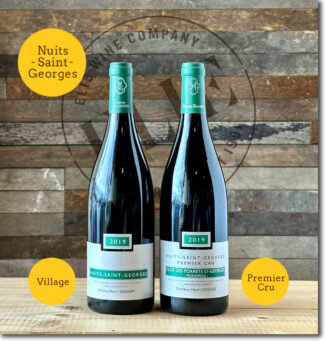 Maison Henri Gouges, 2019 Nuits-Saint-Georges ($81)
Maison Henri Gouges, 2019 Nuits-Saint-Georges ($81)
Domaine Henri Gouges makes this outstanding Nuits-Saint-Georges by blending estate fruit with neighboring organic vineyards and bottles it under ‘Maison’ Henri Gouges. A nose of wild blackberry drives the wine, which shows a touch of herb and musk that should become more pronounced with a bit of age.
Domaine Henri Gouges Nuits-Saint-Georges, 2019 Premier Cru Clos des Porrets St-Georges ‘Monopole’ ($126)
Clos de Porrets is a nine-acre lieu-dit within the wider Les Porrets Premier Cru; it is comprised of deep, stony soils with a good amount of clay covering a hard, limestone base that allows for plentiful drainage. Somewhat unique, beside Pinot Noir, the vineyard also contains a variety named for Henri Gouges. Pinot Gouges is a white-skinned mutation of the notoriously unstable red cultivar. The wine shows strawberry and rich black plum, and is brightly acidic behind a layered, dense texture. A wonderful wine for the long haul.
$238 Gevrey-Chambertin Village vs. Premier Cru
As those schooled in Burgundian lore know, during the nineteenth century it became fashionable for villages in the Côte d’Or to adopt double-barreled names, adding a hyphen followed by the name of their most famous vineyard: Thus Chambolle added Musigny and Gevrey added Chambertin.
In minimalism, less may be more, and in wine—especially those with a hyphenated name—more may be less; a village-level Gevrey-Chambertin, for example, does not seek to compete with the quality of ‘Le Chambertin’ itself. But if nothing else, its name reminds you that it comes from a rarefied zip code. And to be sure, the region is hallowed grapeland, graced with the Holy Trinity of terroir—elevation, climate and soil structure. Contained within the appellation are nine Grand Crus and 26 Premier Crus (whose name on the label may be followed by the name of the climat of origin) as well as well as nearly a thousand acres of Village wine.
Domaine Heresztyn Mazzini
Florence and Simon Heresztyn-Mazzini hail from different winemaking regions—Florence from Burgundy and Simon from Champagne. After ten years of working Heresztyn-owned vineyards in Gevrey-Chambertin, the couple decided to start their own venture on 14 acres spread across the villages of Gevrey-Chambertin, Morey-Saint-Denis, and Chambolle-Musigny. 2012 was their first vintage.
Florence maintains, “We are closely attached to the Côte de Nuits and its unique terroirs and work relentless to bring out the region’s best qualities. Simon and I make it a point of personal pride to respect the region’s soils and natural environment.
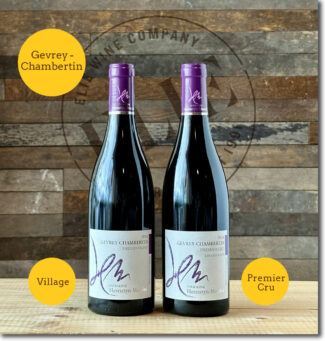 Domaine Heresztyn Mazzini ‘Vieilles Vignes’, 2016 Gevrey-Chambertin ($89)
Domaine Heresztyn Mazzini ‘Vieilles Vignes’, 2016 Gevrey-Chambertin ($89)
Using grapes taken exclusively from older vines, team Heresztyn-Mazzini relies on 35% whole bunch with wild yeast fermentation, then pre-ferments using cold maceration. Punch downs take place three to four times a day, and the wine is aged in 30% new wood oak barrels for 16-18 months, then bottled at the estate without fining or filtering.
Domaine Heresztyn Mazzini, 2016 Gevrey-Chambertin Premier Cru Goulots ($140)
Les Goulots is a five-acre Premier Cru climat at the northern end of the Gevrey-Chambertin vineyard; it is one of the most elevated sites in the Côte de Nuits, and is planted entirely to Pinot Noir. the steep vineyards on the edge of the Côte d’Or face almost due east, giving vines an exposure that is quite different to the climats further south. Les Goulots shares this characteristic, and the mesoclimate here is much cooler, as shade comes to the vineyard much earlier in the day than in the south-facing vineyards directly west of Gevrey-Chambertin village, including the famed Clos Saint-Jacques vineyard. The wine is tight and focused, glossy quality, showing cool red fruit on the palate and a long finish with nice tannin support, both from the grapes and the oak.
$270 Vosne-Romanée Village vs. Premier Cru
Originally named just Vosne, the village took the suffix Romanée in 1866 in honor of its most prized vineyard, La Romanée—a habit of many Burgundy communes of the era. From the perspective of a wine lover, it may be grouped together with neighboring Flagey-Echézeaux; while the villages are entirely separate, their finest vineyards are clustered together immediately north of Vosne-Romanée and take that latter title.
The entire surface area of Vosne-Romanée Grand Crus vineyards (excluding Flagey-Echézeaux) is 67 acres, about half the size of the single Clos de Vougeot climat just across the commune boundary. Even so, the commune of Flagey-Echézeaux with the Echézeaux and Grands-Echézeaux sites included, has more Grand Cru surface area than the Premier Crus and Villages combined. Vosne-Romanée is divided between six individual climats—La Grande Rue, La Tâche, Richebourg, La Romanée, Romanée-Saint-Vivant and the most famous, Romanée-Conti. The best vineyards lie on the mid-slope of the Côte d’Or escarpment. Around these prestigious sites are dotted the Premier Cru vineyards and some entirely unclassified land—the difference between a Grand Cru vine and one deemed worthy only of the regional Bourgogne appellation is sometimes a matter of a few feet.
Domaine Richard Manière
Domaine Manière, located in the heart of Vosne Romanée, has been managed by the Manière family for three generations. Richard Manière (a former rugby player) now owns the 20 acre vineyard, having taken over from his parents in 1998.
With plots from Nuits-Saint-Georges to Fixin in the north of the Côte de Nuits, Vosne-Romanée is the flagship appellation represented in Richard’s portfolio. He farms . Richard’s vineyards are farmed using the ‘lutte raisonnée’ method, with manual soil tillage, 100% manual harvesting and traditional Burgundian vinification.
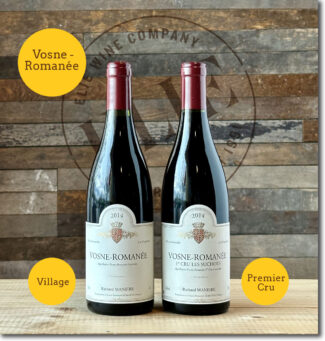 Domaine Richard Manière, 2014 Vosne-Romanée ($110)
Domaine Richard Manière, 2014 Vosne-Romanée ($110)
A beautiful expression of Vosne’s characteristic smoky aromas, with raspberry, mocha and roast coffee leading to a sweet-tannin finish and good length.
Domaine Richard Manière, 2014 Vosne-Romanée Premier Cru Les Suchots ($160)
Planted entirely to Pinot Noir, Les Suchots is the largest Premier Cru climat in Vosne-Romanée; the vineyard separates Echézeaux and Romanée-Saint-Vivant. The 32 acre vineyard sits along the northern border of the Vosne-Romanée commune, although this is something of an academic distinction given that vineyards on the other side of this administrative line in Flagey-Echézeaux adopt the Vosne-Romanée name by convention. The wine is ethereal, showing the mature edge of dried cherry, mushroom, umami and spice.
$339 Chambolle-Musigny Village vs. Premier Cru
Along with Vosne-Romanée, the communes of Chambolle-Musigny and Gevrey-Chambertin round out the ‘Big Three’ of Burgundy reds. Much has been written to compare the last two, perhaps best summarized by Nadine Gublin of Domaine Jacques Prieur: “Chambertin has a colder climate and tends to have more structure than Musigny; Musigny is more forward and elegant; it has a body that is very silky and satiny, while Chambertin has greater finesse, but needs more time to reveal itself—it is more serious and discreet.”
There is a marked difference in size, too: Chambolle-Musigny is relatively small, covering five hundred acres, of which 180 are Premier Cru—the appellation has 24. There are also two Grand Cru climats, Bonnes-Mares, which links its vineyards to those of Morey-Saint-Denis, and Musigny, overlooking the Clos de Vougeot. The prestigious Premier Cru site Les Amoureuses, however, is doubtless on their level.
Domaine Lécheneaut
Having been founded in the 1950s by Fernand Lécheneaut, the domain launched modestly, with five acres of vineyard in Nuits-Saint-Georges, Chambolle-Musigny and Morey-Saint-Denis. During these early years, Lécheneaut sold bulk wine to négociants, but in 1985, his sons Philippe and Vincent took over and brought with them an expanded vision. They grew their vineyard holdings while they began to bottle at the estate. The new Lécheneaut plots, including several Premier Cru vineyards in Chambolle-Musigny and Gevrey-Chambertin, speckle the map of the Côte de Nuits from north to south, but judiciously—many of the holdings are under an acre. With vines in 23 appellations, the total land under their management is around thirty acres.
As the Lécheneaut brothers approach retirement, Vincent’s son Jules has joined the team with a view toward combining lessons learned in his experiences working vines in Oregon with the exceptional terroir his family nurtures.
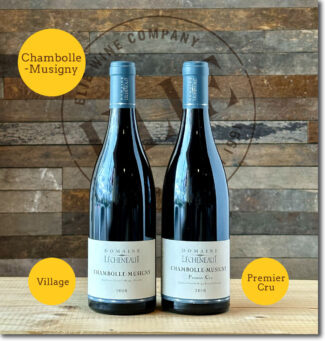 Domaine Lécheneaut, 2018 Chambolle-Musigny ($126)
Domaine Lécheneaut, 2018 Chambolle-Musigny ($126)
From a single acre site of 63-year-old vines across several Villages-level lieux-dits, Chardannes, Herbues, Maladières and Babillère. Most feature thin bedrock soils where cracks in the limestone encourage root exploration, and ensure a marvelous complexity. The bouquet of violets and rose petals introduces a wine which is beginning to age into spicy maturity with prunes and truffles and a palate that has evolved with rich, silken tannins. 2400 bottles made.
Domaine Lécheneaut, 2018 Chambolle-Musigny Premier Cru ($216)
A tiny plot (smaller than a quarter-acre) of 70-year-old vines in ‘Les Plantes’ and ‘Les Borniques.’ These lieux-dits are located on the alluvial cone of the Ambin valley and the substratum is composed of Periglacial red silt enriched with breccias of the Bathonian limestone that forms the plateau. Sophisticated and elegant, the wine presents rich aromas of blackberry, blueberry, redcurrant and ripe plum which over time should develop into leather, chocolate and pepper notes. 1000 bottles made.
$270 Morey-Saint-Denis Village vs. Premier Cru
Forming a stylistic bridge between the firm, fleshy wines of Gevrey-Chambertin and the perfumed wines of Chambolle-Musigny, Morey-Saint-Denis is a wealth of Crus, including twenty Premier Crus and five Grand Crus: Clos de Tart, Bonnes-Mares, Clos de la Roche, Clos Saint-Denis and Clos des Lambrays. The best sites are planted on thin, well-drained, oolitic limestone soils that date from the Middle Jurassic, and occupy the middle slopes while lesser quality wines are produced on the highest and lowest elevations.
Even among Burgundy enthusiast, the Premier Cru climats are sometimes unfamiliar, due in part to the practice of blending several vineyards as a generic Morey-Saint-Denis Premier Cru bottling, something that is somewhat more common here than in other communes.
Domaine Lécheneaut, 2018 Morey-Saint-Denis ($126)
A textbook Morey-Saint-Denis blend of parcels from Pierres Virants, En Seuvrey, Les Cognées and Les Porroux, where the vines are rooted in limestone and chalky-clay soils from the Jurassic period; Bathonien white oolite on the top of the hill and Bajocien chalk on the downslope. The wine is rich and assertive with Gevrey-Chambertin’s muscle and Chambolle-Musigny’s grace—its tone is suggestive of tart cherries, rose hips, violets and walnuts and fills out with stony persistence.
Domaine Jean-Michel Guillon & Fils
Local boy makes good’ is a common enough tale in Burgundy, where land—which can command a price tag twice that of Bordeaux—is generally held by families. Most success stories involve inheriting it or marrying it. Rare is the breakthrough of an outsider who can, for example, step off a train in Gevrey-Chambertin without connections or formal wine training and forge a Burgundian empire within an enclave already pretty imperialistic.
Enter Jean-Michel Guillon. Born into a military tradition, Jean-Michel Guillon chose to settle in France after his past service in the Polynesian Islands and in 1980, without much formal training, planted grapes on five acres of land. What began as a nascent fascination grew into an overarching passion, and the estate today covers nearly forty acres spread over more than 20 appellations. It is work that, like the best Gevrey-Chambertin wines, took years to peak, both stylistically and critically: 2020 turned out to be Jean-Michel Guillon’s best vintage ever.
He explains: “It is all the result of my love for this land, and any acclaim I have received is based on innovative production processes and more importantly, taking into account the ecological needs of the vine. The climate crisis and the scarcity of natural materials is taken very seriously at the winery. Global warming is at the heart of the destruction of habitat destruction and the appearance of certain diseases. In order to facilitate cultivation and harvesting, we have worked diligently worked to reduce our carbon footprint by using phytosanitary products that respect the environment.”
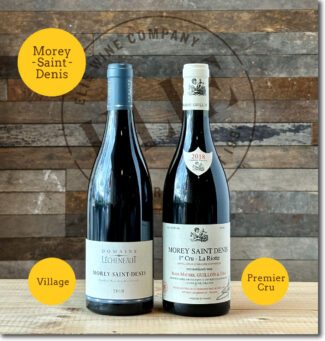 Domaine Jean-Michel Guillon & Fils, 2018 Morey-Saint-Denis Premier Cru La Riotte ($144)
Domaine Jean-Michel Guillon & Fils, 2018 Morey-Saint-Denis Premier Cru La Riotte ($144)
La Riotte is one of 20 Premier Cru climats in the center of tiny Morey-Saint-Denis, and like most of the others, it is planted entirely to Pinot Noir. The six-acre vineyard runs alongside one of the roads running east, out of the village of Morey and down the slope towards the road that runs the length of the Côte d’Or vineyards, and the name is believed to be a corruption of la ruotte—‘the road.’ Riotte’s terroir is built around limestone-based soils containing a good proportion of clay in the soil, which stores sufficient water to keep vines hydrated without being excessive. The wine shows classic Morey-Saint-Denis structure, being medium-bodied and complex with a floral, spice-inflected nose and a chiseled, red-fruit palate.
A Gift That Keeps On Giving
Membership To ‘The Champagne Society’
Bimonthly Subscription
 Not only is Champagne the quintessential drink of celebration, it has traditionally been a gift given with ramped-up sentiments. This year we are offering a couple of variations on this theme, beginning with an opportunity to gift a special someone a six-month or twelve-month membership to The Champagne Society. Our pick for December will be packaged in a wrap-ready gift box along with a congratulatory certificate explaining what lies ahead in bi-monthly installments. For more information please visit our website page: A Holiday Gift: ‘The Champagne Society’ Membership 6-Month ($299) or 12-Month ($589) Subscription.
Not only is Champagne the quintessential drink of celebration, it has traditionally been a gift given with ramped-up sentiments. This year we are offering a couple of variations on this theme, beginning with an opportunity to gift a special someone a six-month or twelve-month membership to The Champagne Society. Our pick for December will be packaged in a wrap-ready gift box along with a congratulatory certificate explaining what lies ahead in bi-monthly installments. For more information please visit our website page: A Holiday Gift: ‘The Champagne Society’ Membership 6-Month ($299) or 12-Month ($589) Subscription.
Vintage Journal
2020 – Classical And Age Worthy
François Labet, a négociant whose family has lived in Beaune for 300 years, summarizes the 2020 vintage like this: “An intellectually-challenging vintage; the reds in particular defy easy categorization because the impact of that season varied considerably by terroir. Producers had key decisions to make, especially when to pick and that significantly affected both the style and quality of the resulting wines.
And this is because the most notable feature of this vintage was its early and rapid harvest: Many domains began picking the week of August 17th and while August harvests have been frequent in the 21st century (there were none in the prior century), this was for many domains the first time they had not only started, but completed a harvest before the end of August.
The resulting wines (particularly from earlier harvests where sugars were high and acids intact) are remarkable, both for whites and reds. The season was hot and dry, but water tables were healthy from the mild and wet preceding winter.
Beaune was particularly fortunate and Chef de Cave Frédéric Weber (Bouchard Pere et Fils) describes 2020 as a concentrated and strong vintage: “It reminds me of 2016 for its vibrancy and energy; the wines are voluptuous and structured. A great vintage for the future, like the ‘18s.
2019 – Concentrated And Vibrant
2019 is a vintage that had already generated excitement in Burgundy by harvest-time, and the accolades have grown since. The winter was extremely mild, but the spring was chilly, with April frosts cutting yields, especially in the Mâconnais. Flowering was uneven due to a cooler than average June and some bunches suffered from millerandage, further cutting yields. Temperatures then warmed up rapidly, so that surviving grapes were highly concentrated and produced a small but brilliant vintage, well-balanced and with great potential. The red wines carry a particular punch, classic in style, but with rich fruit and structure promising a broad drinking window.
2018 – Powerful, Voluptuous With Immediate Appeal
Calescent and copious—big words to describe a big vintage, equally fascinating and enjoyable for those who like potent, youthful Pinots and for those willing to wait out a prolonged span of aging. A hot, dry summer generally requires a wet preceding winter to top up groundwater reserves, and 2017/18 was just that. Conditions warmed up in time for a beautiful early flowering—another requirement for a bountiful harvest. The summer, as indicated, was hot and dry, although the farther north you went, sporadic rainfall was welcomed. The only anomaly during the season was hail in Nuits St Georges; two storms striking the south of the village and Prémeaux-Prissey at the end of June and the beginning of July, wiping out as much as 40% of the crop in some vineyards. Due to the heat, the picking window for Pinot Noir was short, as levels for sugars, acids and phenolics rose quickly and called for an early harvest.
2016 – Supple And Accessible
A classic vintage in which the best producers seized victory from the jaws of defeat. In general, the harvest was extremely small (for some it was the tiniest on record) but the grapes that survived the year’s barrage of frosts, rot and heat were generally of exceptionally high quality, renowned for producing wines with balance and poise. The reds, in particular, are rich, ripe; the whites suffered the most, with many producers being hit so badly that releasing a wine became impossible. Overall, what was made in the 2016 vintage tends to be very good, even excellent, but extremely limited quantities means that prices may be on the high side.
2014 – Classic Burgundy, Very Pleasing Reds
Whereas 2014 failed to provide enough showstopper wines to make it legendary, it remains and concentrated and well-structured vintage that rates as excellent. Although much of the summer was lukewarm and drizzly, there were heat spikes and dry spells that, by September, allowed for a leisurely harvest. Work in the cellar separated those bunches affected by damp-weather rot and although yields were lower than normal, quality was high—especially among the reds, which have the character for long-term aging.
- - -
Posted on in Pommard, Volnay, Gevrey-Chambertin, Chambolle-Musigny, Savigny-lès-Beaune, Monthélie, Aloxe-Corton, Auxey-Duresses, Morey-Saint-Denis, Maranges, Nuits-Saint-Georges, Santenay, Vosne-Romanée, France, Burgundy, Wine-Aid Packages | Read more...
The Champagne Society February 2024 Selection : Champagne André Heucq + Champagne Solemme
The Rise of Terroir in Champagne
Two New Waves Producers Cultivate The Variety Meunier To Channel Precise Geography in Two Different Sub-regions
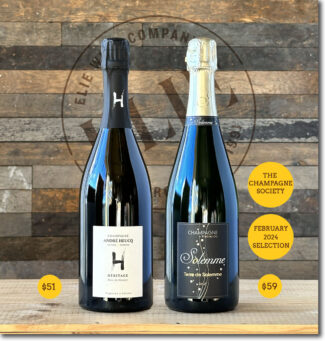
Champagne André Heucq ‘Héritage’ Blanc de Meunier, Vallée-de-la-Marne Brut
Nature ($51)
+
Champagne Solemme ‘Terre de Solemme’, Montagne-de-Reims Premier Cru Villers-aux-Nœuds Brut ($59)
‘First and foremost, Champagne is wine.’
Our Champagne mantra over the past few years has been a bit reductionist: While undeniably accurate, it’s a little like saying that, first and foremost, ‘David’ is a hunk of marble or that at its essence, La Traviata is a bunch of notes. What these self-evident truths leave out is the human touch—the x-factor that makes art from the inanimate and beauty from the base.
As France warms with the rest of the planet, new regional wines are coming into focus and former sow’s ear soils are producing silk purse products. This is a paean to nature, of course, and as always, the passion arises from the people, not from the place. Folks like Alexandre and Fanny Heucq, fourth generation artisan winemakers from the grower house Champagne André Heucq and Olivier Langlais, the winemaker behind Solemme Champagne, who advocates simplicity and honesty in his wines.
These are two standout icons from our Champagne portfolio, but more than that, they are the flesh behind the finesse.
The Impact Of Climate Change on Champagne: Heating-up
Global wine production in 2023 was at its lowest in 60 years, and a lot of the decline can be blamed on extreme weather events, many of which have been worsened by climate change. Italy dropped from its position as the world’s leading wine maker due to numerous adverse weather events, including erratic rainfall that triggered downy mildew as well as floods, hailstorms and drought. In 2021—for the same reasons—Champagne saw the smallest harvest since 1957.
Somewhere amid all these clouds is a silver lining known as the Goldilocks Zone, and we may be living within it as we speak. Ripening grapes has always been a primary challenge in Champagne, located near the northern growing zone limit of its three principal grapes, Chardonnay, Pinot Noir and Meunier. Although the rise in temperature (nearly two degrees between 1961 and 2020) has beneficial effects in the short term, especially at higher elevations, the downsides are legion—earlier budburst makes the risk of frost damage more pronounced, and frost control systems, especially those based on combustion, add to the region’s carbon footprint. Not only that, but warmer days often precede warmer nights, affecting a grape’s natural ability to retain acid, giving Champagne its intangible ‘zing’.
Despite magnanimous efforts to reduce their carbon emissions, including use of bio-based products in the fields and cellars, scrapping much of the mineral fertilizers used in the past and planting of hedges and trees allowing a better absorption of CO2 and storage of carbon in soils, the warming of the region is likely to continue for the foreseeable future—potentially, according to ClimateAi, making Chardonnay and Pinot Noir (and to a slightly lesser extent, Meunier) impossible to grow in the area currently defined as Champagne.
That means we may well be in the midst of a ‘best of both worlds’ phenomenon in Champagne, where the positives still outweigh the negatives and we are able to enjoy riper, richer wine that is today (more often than in the past) of vintage quality. By 2050, who knows?
The Biodynamic Principles: Respecting Earth’s Life Forces
Credit Dr. Rudolph Steiner for codifying the basic principles of biodynamics; his 1924 lecture series to farmers opened a wormhole that integrated scientific understanding with a recognition of an underlying spirit in nature and, indeed, in the cosmos at large. In Cliff’s Notes shorthand, the movement recognizes every farm, garden or vineyard as an integrated organism made up of interdependent elements: Plants, animals, soils, compost, and the classically French view of ‘the spirit of a place.’ Biodynamic farmers listen to the land and work to nurture and harmonize these elements, managing them in a holistic and dynamic way. The goal, whether the crop is grain or grapes, is to develop and evolve a given plot of land as a unique individuality.
These principles are custom made to accentuate terroir, but in Champagne, distinctiveness of location has often taken a back seat to a homogenous blend. As a result, the region as a whole was a bit late to the biodynamic party. The era between 1970 and 2000 may be viewed as cringe-worthy in terms of viticulture; the overuse of pesticides and herbicides and the once-favored fertilizer known as ‘boues de ville’—urban waste—damaged soils even in the most prestigious Grand Cru vineyards.
The biodynamic sun came out at turn of the century, when the Comité Champagne conducted in-depth research into the industry’s environmental impact and launched an ambitious plan, resulting in a 20% reduction in carbon emissions per bottle and a 50% reduction in the use of both phytosanitary products and nitrogen fertilizers. A regional sustainability certification, VDC (Viticulture Durable en Champagne), was introduced in 2014 and today, 15% of Champagne’s vineyards falls under the certification, and ambitions are much higher for the future.
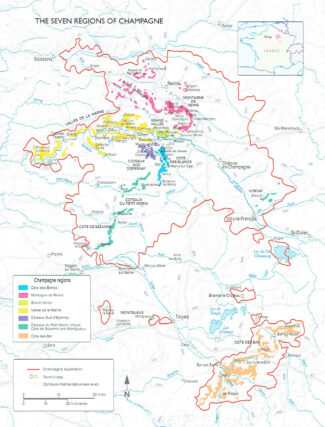
Mountains and Valleys: Two Artisans, Two Different Meunier-Centric Champagne Expressions
For the trend conscious (as well as the eco-conscious), Meunier, often the odd-grape-out in discussions of Champagne dominant trio of varietal, is enjoying something of a heyday with a growing legion of fans, both for its frost-resistance and its bright, bergamot-tinted profile. Of the planted acres in Champagne, Meunier represents about 31%, or roughly 84,000 acres. In the Marne Valley, however, it dominates, making up more than 60% of the vineyards.
The valley is long—it extends more than sixty miles from the city of Tours-sur-Marne to Château-Thierry, wending thorough two départements, the Marne and the Aisne, all the way to the limits of Seine-et-Marne. As its name indicates, the Marne Valley follows the river through a landscape of rolling hills and small villages. Vines are planted on both banks although those on the north side benefit from a more favorable southern to eastern sun exposure.
The variety of Marne terroirs within its various villages and numerous sub-zones is expansive; in addition, the geology of the soils are more variable in Marne than in other Champagne sub-regions. As a result, the styles of Champagne, even those made mostly or entirely from Meunier, can vary widely. In the Petite Montagne, for example, the Meunier tends to be firmer and more structured, while the wines of the Vallée de la Marne are broader and more ample in build.
Representative of the many faces of Meunier are the artisan producers featured in this week’s package, Alexandre and Fanny Heucq of Champagne André Heucq (whose mineral-focused Meunier is the result of their unique green Illite soils) and Olivier Langlais of Champagne Solemme, a vigneron who stands out from the pack as a true maverick, making Champagnes using only the year’s wines.
The Villages of The Vallée de la Marne: Coldest Weather in Champagne, Clay-Rich Soils
The most famous villages are located at the eastern end of the valley around the city of Épernay, a ranking that reflects the importance given to the presence of chalk in the soil. Chardonnay and Pinot Noir dominate the vineyards of the eastern end of the region, and the major Champagne houses located here include Billecart-Salmon or Philiponnat in Mareuil-sur-Aÿ, Deutz and Bollinger at Aÿ and Jacquesson in Dizy.
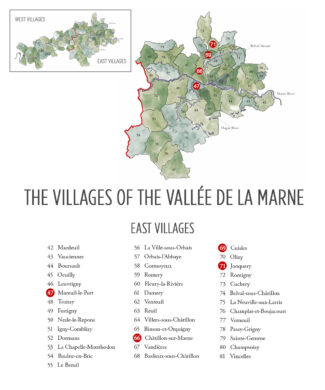
West of Châtillon-sur-Marne, chalk tends to be found more deeply buried in the ground; the topsoil is made of calcareous clay and clay marls. The combination of cold weather and rich clay makes Pinot Meunier the grape of choice in this part of the valley and it is here that a new generation of experimental winemakers is deepening their own (and by proxy) our understanding of the varietal.
Fanny & Alexandre Heucq
Champagne André Heucq
In the heart of the Marne valley is the tiny commune of Cuisles (population 150) which happens to be an epicenter for the green illite clay; it is unique to Cuisles and two surrounding villages and it is arguably the terroir where Meunier feels most at home.
According to André Heucq, who—along with his daughter Fanny— specializes in Meunier grown on fifteen acres of estate vineyards, “Green clay retains water better than chalky soils, this type of soil needs less water than classic clay-limestone soils. Generally speaking, the Marne Valley is prone to downpours of rain, and this is where Cuisles’ unique position in the hollow of the valley plays a fundamental role: Showers are much less frequent, so soil and climate are in perfect alchemy for optimum ripening of the Meunier.”
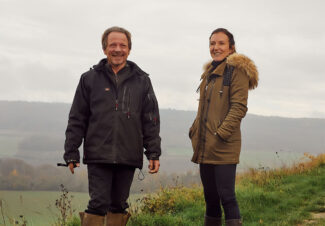
André & Fanny Heucq, Champagne André Heucq
Fanny says that the terroir, so vital to their wines’ purity and elegance, is enhanced by a commitment to biodynamics: “Production that respects the environment reactivates the vine’s natural self-defense mechanisms, allowing us to do away with the use of chemicals and use very low doses of copper and sulfur.
Among the strictest (and most interesting) of the cosmos-oriented techniques the estate relies on is the ‘500’—a preparation is obtained by fermenting good quality cow manure in the soil over the winter, introduced via cow horns. Fanny explains, “This preparation is aimed at the soil and plant roots. Its name comes from the fact that it contains over 500 million bacteria per gram. The silica from the horn is equally important. It is complementary to and acts in polarity with the 500. It is not aimed at the soil, but at the aerial part of plants during their vegetative period. It can be said to be a kind of “light spray”, which can promote vegetative vigor or, on the contrary, attenuate excessive luxuriance. It brings a luminous (crystalline) quality to plants, and reduces their tendency to disease. Not only does it reinforce the effects of sunlight, it also enables a better relationship with the cosmic periphery, with the entire cosmos. This preparation is essential for the internal structuring and development of plants. It promotes vertical plant growth. It makes plants firmer and more supple. It increases the quality and resistance of leaf and fruit epidermis.”
Views From The Right Bank: Meunier Reigns Supreme
Not only an underdog but occasionally an afterthought, growers in Champagne have often planted Meunier vines in areas that will not support the appellation’s noble couple, Chardonnay and Pinot Noir. Older vines are often found in otherwise marginalized areas, and the grape is not permitted to wear the designation ‘Grand Cru’ even if it is grown exclusively in a Grand Cru village. As a logical result of this elitism, very little Meunier is grown in Grand Cru vineyards and many producers avoid using it in their vintage wines due to its rumored inability to age—a rumor which, incidentally, is unfounded.
As in Bordeaux, the difference between the right and left banks of the region’s dominant river are striking, both in terms of vineyard exposure and soil composition. The Marne is an eastern tributary of the Seine in an area east and southeast of Paris. In Champagne, where it runs west toward Epernay, the right bank sports the valued south/southeast exposure that maximizes sun exposure and aids grape ripening. As with the Right Bank of the Dordogne River in Bordeaux, the Marne’s right bank contains more clay, making it more suited to Meunier than either Chardonnay or Pinot Noir, which may struggle to ripen in the area’s cool, frost-and-fog-prone microclimate.
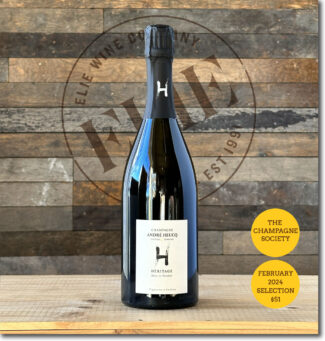 Champagne André Heucq ‘Héritage’ Blanc de Meunier, Vallée-de-la-Marne Brut Nature ($59)
Champagne André Heucq ‘Héritage’ Blanc de Meunier, Vallée-de-la-Marne Brut Nature ($59)
TCS-1 ($51)
A blend of 100% Meunier harvested in 2016/2017 from 30-year-old vines grown in illite-rich plots in Cuisles, Chatillon sur Marne, Serzy and Mareuil le Port. The wine underwent full malo and spent 48 months on lees; it was dosed to Brut Nature. The nose is nicely spiced with stewed apple and pear with notes of jasmine. A slight lemony bitterness on the finish is a mirror of the terroir. 25,000 bottles made.
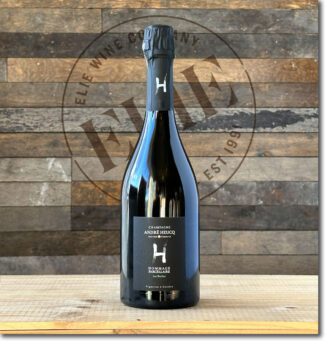 Champagne André Heucq ‘Hommage Parcellaire’, 2015 Vallée-de-la-Marne – Jonquery ‘Les Roches’ Brut Nature ($117)
Champagne André Heucq ‘Hommage Parcellaire’, 2015 Vallée-de-la-Marne – Jonquery ‘Les Roches’ Brut Nature ($117)
100% Meunier from younger vines—22 years old—grown in illite in the ‘les Roches’ lieu-dit in Jonquery. The wine is from the 2015 harvest, fermented ‘en barrique’ and aged three years on lees after undergoing full malo. Dosed to Brut Nature. The wine’s bouquet is of peach and plum with notes of pie crust and almond. The long and pronounced minerality in the finish is indeed an earthy homage to the parcel from which it arises. Only 800 bottles were made.
The Montagne de Reims: Grande, Petite, North And The Grand Vallée
Located between Reims and Épernay, the Montagne de Reims is a relatively low-lying (under a thousand feet in elevation) plateau, mostly draped in thick forest. Vines find a suitable home on the flanks, forming a horseshoe that opens to the west.
So varied are the soils, topography and microclimates here that it is not possible to speak of the region in any unified sense. Grande Montagne de Reims, which contains all of the region’s Grand Cru vineyards, covers the northern, eastern and southern slopes of the viticultural area, and Pinot Noir plantings dominate at 57%, followed by Chardonnay (30%) and Meunier (13%). Its vineyards face a multitude of directions, and soil type varies by village, giving rise to a breadth of Pinot Noir expressions, as well as exceptional Chardonnay.
To the west, the Grande Montagne de Reims gives way to the Petite, whose bedrock is chalk, but softer than the chalk found further south on the Côte des Blancs. This sort, called ‘tuffeau’, is an extremely porous, sand-rich, calcium carbonate rock similar to what is found in wine regions of the middle Loire Valley.
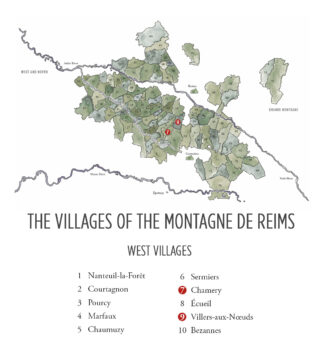
In French, the word ‘petite’ often to refers to a ‘lesser’ commodity, but with La Petite Montagne, the reference is to elevation. This lower elevation means warmer weather, even in Champagne’s northerly climate, and in certain villages, the soil contains more sand, making it an ideal environment for growing Petit Meunier.
Meunier accounts for approximately half of the plantings in the Petite Montagne, with Pinot Noir making up 35% and the rest Chardonnay. It is a growing conviction among growers of the modern era that Meunier is a Champagne grape whose time has come, especially as an age-worthy variety.
Emmanuel Brochet of Villers-aux-Noeuds says, “People claim that Meunier ages too quickly, even faster than Chardonnay. I disagree. The curve of evolution is different. Meunier is quick to open and more approachable in youth, but then it becomes quite stable. Chardonnay tends to open later, but old Meunier remains very fresh and lively.”
Olivier Langlais
Champagne Solemme
The name Solemme is a combination of ‘sol’ for the sun, with the addition of a feminine suffix. “My goal,” says cellar master Olivier Langlais, “is to make delicate Champagnes that are bright like the sun.”
La Petite Montagne-de-Reims, to the west of the road between Reims and Épernay, boasts steep slopes and chalky soils, making it the home of some of the best Premier Cru vineyards in Champagne—Savart, Brochet, Egly-Ouriet, etc. Also calling the region home is Olivier Langlais, who farms fifteen acres of organic vineyards in the terroir around Villers-Aux-Noeuds. A true exception in Champagne region, he makes wines using only the product of the harvest year.
His dedication to biodynamics and agriculture according to the cycles of the moon began with the Chardonnay plot in 2009 and finished the transition with his oldest vines of Pinot Noir in 2015. The vineyard is composed of 50% Pinot Meunier, 25% Chardonnay and 25% Pinot Noir divided between six villages—five of them Premier Cru. Most of the plots, as is the case of most Petit Montagne de Reims vines, are southeast/east oriented.
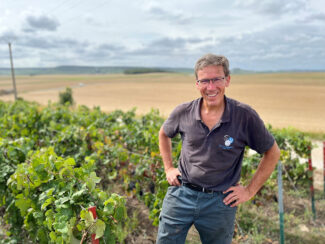
Olivier Langlais, Champagne Solemme
“Everything is happening in the exchange between the soil and the grape”, Olivier points out. “That’s why the difference of terroir between all parcels determines variety and process. Villers-aux-Noeuds has a classic chalky soil, bringing a lot of minerality to the Chardonnay and Meunier growing there. Clay-limestone dominates Chamery and Vrigny, with a bit more clay in Vrigny, where Meunier gets better results—clay gives more ‘gras’, or roundness to the grapes. Often not mentioned is the sandy soils of Villedomange and Eceuil, which gives Pinot Noir a concentrated and elegant form.”
Once in the cellar, Olivier is a champion of a hands-off approach. He never chaptalizes and uses only natural yeast from his vineyard. “In the chai, you won’t find any barrels,” he says. “We do not filter, there is no addition of SO2 and all the cuvées spend between 36 to 48 months on the lees as a means of better expressing the terroir. 90% of the time, I don’t do any malolactic fermentation, because I prefer to let the natural minerality shine.”
Transformation in The Petite Montagne: Meunier Shares Space With Pinot Noir
The western portion of the Montagne de Reim—the so-called Petite Montagne—stretches from Gueux in the north to Sermiers in the south, on the western side of the main road that runs between Epernay and Reims. Although this region has a historical fondness for Meunier, some acres have been replanted to Pinot Noir in recent years, potentially doing a disservice to the vineyards north of Écueil in the villages of as Sacy, Villedomange, Jouy-lès-Reims, Coulommes-la-Montagne, Vrigny and Gueux. But the soils here are generally more overtly calcareous than those in the Vallée de la Marne and can contain a high proportion of fossils. In Écueil, there is sand on the lower slopes, acting as a defense against phylloxera, allowing some growers to plant Pinot Noir on the original rootstocks, so this becomes the cultivar of choice.
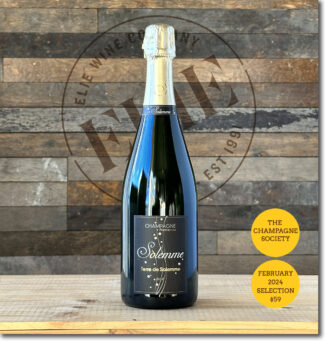 Champagne Solemme ‘Terre de Solemme’, Montagne-de-Reims Premier Cru Villers-aux-Nœuds Brut (68)
Champagne Solemme ‘Terre de Solemme’, Montagne-de-Reims Premier Cru Villers-aux-Nœuds Brut (68)
TCS-2 ($59)
Villers-aux-Nœuds is a Premier Cru village in Vesle et Ardre; about half the vineyards are planted to Pinot Noir, with Meunier making up about 30%, and the rest, Chardonnay. Olivier Langlais farms fifteen acres here; the land is relentless hilly and the soil is made up of Cretaceous chalk under a few inches of ‘argilo-calcaire’ topsoil. Disgorged according to the moon cycle (a feature of his brand of biodynamics), ‘Terre Solemme’ is a blend of 55% Meunier, 25% Pinot Noir, and 20% Chardonnay aged three years on the lees. Buttery toast on the nose along with cooked apple and cantaloupe. The palate has an echo of the nose and a nice marzipan richness that drives the mineral finish home.
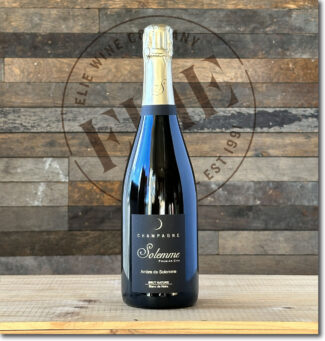 Champagne Solemme ‘Ambre de Solemme’, 2016 Montagne-de-Reims Premier Cru Villers-aux-Nœuds ‘La Motelle’ Blanc de Noirs Brut Nature ($99)
Champagne Solemme ‘Ambre de Solemme’, 2016 Montagne-de-Reims Premier Cru Villers-aux-Nœuds ‘La Motelle’ Blanc de Noirs Brut Nature ($99)
100% Meunier from the ‘La Motelle’ lieu-dit, filled with 50-year-old Massal-selected vines; these grapes were harvested somewhat late and developed a spectacular ripeness. ‘Ambre’ refers to the color, whose slight tint is the result of skin-contact. The nose sets out with fresh apple and a touch of grapefruit and strawberry coming out, with bold acidity reflected in a spine of salinity that balances an otherwise rich and creamy wine.
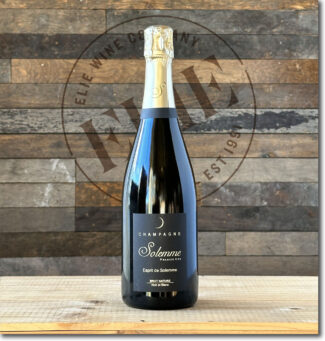 Champagne Solemme ‘Esprit de Solemme’, 2018 Montagne-de-Reims Premier Cru Brut Nature ($79)
Champagne Solemme ‘Esprit de Solemme’, 2018 Montagne-de-Reims Premier Cru Brut Nature ($79)
2018 was an excellent vintage in Champagne; the crop was large and healthy, rich in sugar and flavor depth, with all three major grape varieties performing well. ‘Esprit de Solemme’, 2018, is equal parts Pinot Meunier and Chardonnay drawn from chalky soil in Villers-aux-Nœuds and the clay-limestone hillsides of Chamery. This cuvée shows a lovely bouquet: cream, biscuits, pineapple and toasted nuts. The palate is very dry but stays in balance with cream and salinity through the finish.
Notebook ….
Drawing The Boundaries of The Champagne Region
Having been defined and delimited by laws passed in 1927, the geography of Champagne is easily explained in a paragraph, but it takes a lifetime to understand it.
Ninety-three miles east of Paris, Champagne’s production zone spreads across 319 villages and encompasses roughly 85,000 acres. 17 of those villages have a legal entitlement to Grand Cru ranking, while 42 may label their bottles ‘Premier Cru.’ Four main growing areas (Montagne de Reims, Vallée de la Marne, the Côte des Blancs and the Côte des Bar) encompass nearly 280,000 individual plots of vines, each measuring a little over one thousand square feet.
The lauded wine writer Peter Liem expands the number of sub-regions from four to seven, dividing the Vallée de la Marne into the Grand Vallée and the Vallée de la Marne; adding the Coteaux Sud d’Épernay and combining the disparate zones between the heart of Champagne and Côte de Bar into a single sub-zone.
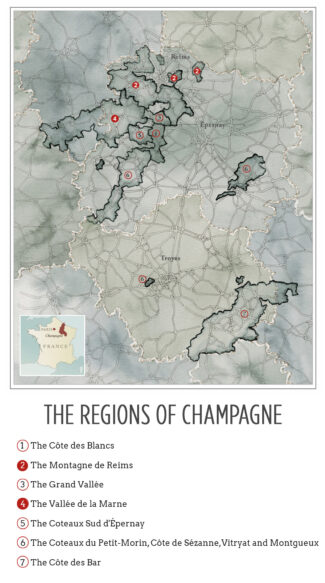
Lying beyond even Liem’s overview is a permutation of particulars; there are nearly as many micro-terroirs in Champagne as there are vineyard plots. Climate, subsoil and elevation are immutable; the talent, philosophies and techniques of the growers and producers are not. Ideally, every plot is worked according to its individual profile to establish a stamp of origin, creating unique wines that compliment or contrast when final cuvées are created.
Champagne is predominantly made up of relatively flat countryside where cereal grain is the agricultural mainstay. Gently undulating hills are higher and more pronounced in the north, near the Ardennes, and in the south, an area known as the Plateau de Langres, and the most renowned vineyards lie on the chalky hills to the southwest of Reims and around the town of Épernay. Moderately steep terrain creates ideal vineyard sites by combining the superb drainage characteristic of chalky soils with excellent sun exposure, especially on south and east facing slopes.
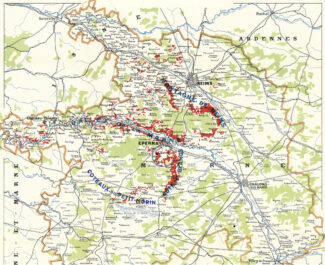
Single Harvest vs. Vintage
In France, under Appellation d’Origine Contrôlée (AOC) rules, vintage Champagnes must be aged for three years—more than twice the required aging time for NV Champagne. The additional years on the yeast is said to add complexity and texture to the finished wine, and the price commanded by Vintage Champagne may in part be accounted for by the cellar space the wine takes up while aging.
On the other hand, a Champagne maker might prefer to release wine from a single vintage without the aging requirement; the freshness inherent in non-vintage Champagnes is one of its effervescent highlights. In this case, the wine label may announce the year, but the Champagne itself is referred to as ‘Single Harvest’ rather than ‘Vintage’.
- - -
Posted on 2023.12.01 in France, The Champagne Society, Champagne | Read more...
The Champagne Society December 2023 Selection: Champagne Marguet
Marguet’s Naturally Grown Champagne Channels His Biodynamic & Homeopathic Practices
Champagne Marguet
Grand Crus: Ambonnay And Bouzy
Champagne Marguet ‘Yuman 2019’ Premier Cru Blanc de Blancs Brut Nature ($55)
AND
Champagne Marguet ‘Yuman 2019’ Premier Cru Blanc de Noirs Brut Nature ($55)
True disciples call it wine’s inevitable future, and even the naysayers are beginning to admit that after years of practicing biodynamics, the dividends are irrefutable. And nowhere in Champagne is this more evident than at Champagne Marguet, where Benoît Marguet is one of the few growers in the region to have thrown himself, both body and soul, vineyard and cellar, into homeopathy.
It’s easy to think of Champagne as a spiritual substance; after all, it was created by monks and the very airiness of its identity seems celestial. The cornerstone of biodynamics is a view of the vineyard, and its subsequent produce, in like terms—as a singular organism capable of self-healing and self-propagation. Natural material alone sustains the soil; chemical fertilizers and pesticides are forbidden and instead, a range of animals are encouraged to create a rich, fertile environment in which the vines can thrive.
For Benoît Marguet, this goes beyond biodynamics as a concept; it’s a vision of complete harmony in every stage of winemaking and an improvement in his own personal life which translates into his Champagne.
Exploring Pinot Noir Country: The Montagne de Reims
Forming a broad and undulating headland that covers five thousand acres of thicket and vineyard, the Montagne de Reims stretches 30 miles east to west and, north to south, is about five miles wide. The vines hug the limestone slopes of the western and northern flanks and are planted in a huge semicircle that extends from Louvois to Villers-Allerand.
This is Pinot Noir country (except in Trépail and Villers-Marmery, where the Chardonnay can be found). The most northerly of Champagne’s four demarcated regions, the Montagne de Reims is also the most well-known, with more Grand Cru sites than anywhere else in the AOP. Tectonics gave the region mountains of chalk, and the Romans added their two cents by leaving behind huge limestone pits known as crayères. Within, the humidity remains at around 60% and temperatures at a steady 57°F; perfect cellaring conditions to soften the cold-climate acids of Champagne with time on lees. As a result, Louis Roederer, Ruinart, Veuve Clicquot, Krug, Taittinger and Mumm all store wine here.

Benoît Marguet
“A Vitality About The Fruit That Makes It Feel Truly Alive.”
Champagne Marguet has been a bellwether for innovation since 1883, the year that Émile Marguet began to graft his vines onto American rootstocks in the face of the impending invasion of phylloxera. Alas, so ridiculed was the notion throughout Champagne that Marguet wound up tearing out the grafted vines and promptly declared bankruptcy.
Ratchet forward a century and a half: In 2006, Émile Marguet’s distant scion Benoît Marguet joined forces with Hervé Jestin, the former chef de cave of Duval-Leroy, and began to produce a special homeopathic and biodynamic super-cuvée called ‘Sapience’, first released in 2013. Being on the cutting edge of trends has finally paid dividends.

Today, Benoît farms 25 acres of vines, all using biodynamic practices. Most are owned by Marguet himself while the rest are leased from relatives. Among them are eight different lieux-dits with an average vine age of 42 years; each is bottled under the name of the plot and reflects the minute soil differences that exist throughout his holdings as well as the Massale-select varieties he suits to his various terroirs—among them Les Crayères, Les Bermonts, Le Parc and Les Saints Rémys.
The Horses, The Vines and The Eggs
Two techniques keep Benoît Marguet close to his passion; first, since 2009, he has plowed his acres with a pair of draft horses. He argues that by using this method of cultivation roots are forced deeper towards the water table surface, providing a better water supply. In addition, he treats the soil with preparations made of essential oils, tisanes, nettles, citronella, lavender and rhubarb. “The well-being of the soil is a priority,” he points out. “The horse is in connection with the three elements of terroir, the mineral (chalk), the vegetal (vine and flora) and the animal (fauna and human interaction).”
Next, in the cellar, he continues to adhere to the principles of biodynamics by working the wine according to lunar cycles. Under the conviction that the shape of a vat can affect the quality of the wine, he installed special 40-hectoliter egg-shaped wooden cuvée casks produced to his specifications by Tonnellerie Taransaud. The unique shape provides a height/width ratio equal to the Golden Mean or Phi, which Benoît believes is a natural feature repeated throughout the physical world and encourages spiral convection currents and a harmony to better clarify the wine… and his own purpose.
“This symbiosis, with the principle of nature assisting nature, is fascinating research work for me, with influences from various cultures and countries,” Benoît maintains. “In my opinion these fundamental or elemental practices are solutions that instill within our wine its full health benefits, and perhaps even more…”
Blanc de Blancs vs. Blanc de Noirs: Revealing The Fruit
The introductory lesson in Champagne Appreciation 101 is that sparkling wine is made from either light-skinned or dark-skinned grapes, or a combination of both, and all can end up looking a lot the same. This holds especially true in cool-weather climates like Champagne, where vinifying slightly under-ripe grapes is the norm—a point when Pinot Noir and Meunier may not have fully developed their juice-staining anthocyanins. To maintain the desired hue, of course, dark-skinned grapes are pressed gently to keep the skins from bleeding into the juice and the skins separated out quickly.
Holding equally true is the fact that looks can be deceiving. Blanc de Noirs Champagnes made with Pinot Noir and/or Meunier do not share a flavor profile with a Blanc de Blancs made from Chardonnay, and this is the result of both nature and nurture. Generally speaking, a Blanc de Blancs will be a bit lighter and dryer, showcasing the fruits that predominate in Chardonnay’s arsenal—white peach, citrus, green apple and pear. Blanc de Noirs tend to have more body, creamier texture, and the fruit contours are often red; cherry and raspberry, and toasty notes may be more emphatic.
Naturally, the only true lesson in that appreciation course is determining for yourself if you prefer one over the other, and since we are dealing with Champagne, you are more than welcome to respond, “All of the above.”
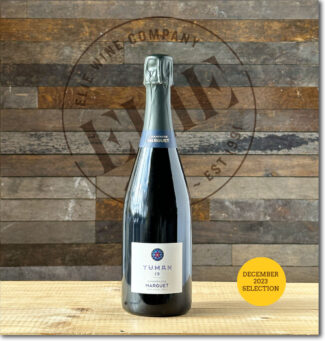 Champagne Marguet ‘Yuman 2019’ Premier Cru Blanc de Noirs Brut Nature D-2/2022 (Sold Out)
Champagne Marguet ‘Yuman 2019’ Premier Cru Blanc de Noirs Brut Nature D-2/2022 (Sold Out)
Yuman is a newer project of Benoit’s that uses organic/biodynamic fruit from two producer friends in Champagne. It is not an estate wine, but is treated just like his other cuvées, seeing a natural fermentation in barrel, and 36 months on the lees. Built upon 100% biodynamic-certified Pinot Noir from the Grand Cru village of Verzenay and Premier Cru village of Cumières, it shows a characteristically crisp acidity behind rich raspberry coulis and aromas of freshly-baked graham cracker.
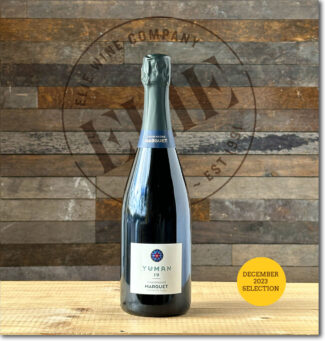 Champagne Marguet ‘Yuman 2019’, Premier Cru Blanc de Blancs Brut Nature D-2/2022 (Sold Out)
Champagne Marguet ‘Yuman 2019’, Premier Cru Blanc de Blancs Brut Nature D-2/2022 (Sold Out)
100% Chardonnay from the Premier Cru village of Vrigny, located in the Petite Montagne de Reims—the northwestern part of the Montagne de Reims. Chardonnay makes this somewhat unusual for Vrigny, which is known primarily for Meunier, a variety that makes up 71% of the vineyard plantings. Bottled in July 2020, disgorged in February 2022 without dosage, the wine shows a beautifully pure, elegant and intensely mineral profile that is textbook Blanc de Blancs.
 Champagne Marguet ‘Yuman 2020’, Premier Cru Blanc de Blancs Brut Nature D-3/2023 (Sold Out)
Champagne Marguet ‘Yuman 2020’, Premier Cru Blanc de Blancs Brut Nature D-3/2023 (Sold Out)
A cuvée based on the 2020 vintage; 100% organic Chardonnay sourced from Benoît’s friends Premier Crus Villeneuve-Renneville and Villers-Marmery in the Montagne de Reims. The wine is a wealth of intensity with crisp, chalky, mineral notes and perfumed Meyer lemon on the nose and palate.
Grand Cru Bouzy and Grand Cru Ambonnay: Always Rivals
Like the Hatfields and the McCoys (only without rebel flags and shotguns), Bouzy and Ambonnay have a longstanding rivalry built on begrudging respect and competitive moxie. At its closest point, the distance between the two communes is shorter than a long drive with a golf club, and each have shored up a reputation for superlative wines from the south side of the Montagne de Reims hill.
Yet connoisseurs will happily point out their favorite qualities in each, generally citing the special elegance of wines from Ambonnay, due in part to undulating, south-eastern exposures that moderate the ripening process.
In contrast, Bouzy exposures are almost entirely to the south, ideal for Pinot Noir. More than nine hundred acres in Bouzy are under vine, with 87% of them Pinot Noir, 12% Chardonnay and a scant 0.2% Meunier. The most prominent Champagne houses with a Bouzy presence are Bollinger, Duval-Leroy, Moët & Chandon, Mumm, Pol Roger and Taittinger.
Nearby Ambonnay shares a nearly identical terroir with Bouzy and is similarly appointed, although with slightly less Pinot Noir grown and a bit more Chardonnay—white grapes account for about 20% of the vineyards. Like Bouzy, ‘Ambonnay Rouge’ represents a small portion of wine production. Prominent Champagne houses that control Ambonnay vineyards include Duval Leroy, Moët & Chandon, Mumm, Piper Heidsieck, Pol Roger and Roederer.
2018 Vintage
2018 checked all the boxes for exceptional Vintage Champagne; the Pinot Noir crop ripened perfectly and the Chardonnay harvest created wines that are full-bodied yet fresh and promise to be long-lasting. Icing on the cake is that the vineyards produced copiously
A few isolated hailstorms led to some crop loss, notably in the Côte des Bar, but the hot, sunny dry days that followed were interrupted only occasionally by (welcomed) rain showers, keeping hydric stress at bay and allowing for optimal ripening at a gradual pace. Harvest was early, beginning on August 20.
Gilles Descôtes, Bollinger’s cellar master, relates his personal experience of the 2018 season: “I experienced this vintage as a relief. As in 2017, we began picking in August, but this time, everything was superb. 2018 is my 26th vintage and I have never seen anything like it.”
 2018 Champagne Marguet Grand Cru Bouzy Rosé Brut Nature D-2/2023 ($95)
2018 Champagne Marguet Grand Cru Bouzy Rosé Brut Nature D-2/2023 ($95)
75% Pinot Noir, 25% Chardonnay from the chalky Bouzy terroir. Fermentation (on native yeast) and élevage is done in neutral oak and the wine is barrel-aged with long lees contact and full malolactic. The wine is juicy with ripe red berries and shows a fine bead that permeates a creamy, yet lively texture.
 2018 Champagne Marguet Grand Cru Bouzy Brut Nature D-2/2023 ($90)
2018 Champagne Marguet Grand Cru Bouzy Brut Nature D-2/2023 ($90)
Fewer than 200 cases of this 100% Pinot Noir, zero-dosage Champagne from Benoît’s scant two acres in Bouzy. Having remained on lees for almost four years, the result is an opulent, powerful champagne with apple and yeast aromas and the slightly oxidative style Marguet is known for.
 2018 Champagne Marguet Grand Cru Ambonnay Brut Nature D-3/2023 ($90)
2018 Champagne Marguet Grand Cru Ambonnay Brut Nature D-3/2023 ($90)
63% Pinot Noir and 37% Chardonnay that features a charming, biscuity nose with dried apple and lemon verbena braced by pure, shivery acidity and an underlying minerality.
 Champagne Marguet ‘Shaman 2019’, Grand Cru Brut Nature D-1/2023 ($66)
Champagne Marguet ‘Shaman 2019’, Grand Cru Brut Nature D-1/2023 ($66)
Grand Crus Ambonnay and Bouzy. 75% Pinot Noir and 25% Chardonnay. The nose shows candied ginger, dried flowers and orange blossom while the palate is creamy with marzipan, citrus and a salted nut finish.
 Champagne Marguet ‘Shaman 2019’, Grand Cru Rosé Brut Nature D-10/2022 ($66)
Champagne Marguet ‘Shaman 2019’, Grand Cru Rosé Brut Nature D-10/2022 ($66)
Grand Crus Ambonnay and Bouzy. 77% Chardonnay, 23% Pinot Noir vinified separately; Marguet works with a Burgundy-like system of Cru selections of single-village wine in good years, and lieux-dits in the best years. Wild strawberries and tea show on the nose, with beautifully integrated tannins and a long, yeasty finish.

Site Specific Grand Cru Ambonnay
Whereas the ‘art’ of Champagne is often discussed in terms of expert blending—much as color is added in layers to create a portrait—a Cellar Master uses a pallet of flavors to create synergy, a whole that is greater than the sum of its parts. Traditionally, ‘house styles’ have been established over decades (even centuries) and homogeneity—in the best sense of the word—is the goal. Even vintage Champagne (assembled from a single harvest, though many villages may contribute) should highlight the house approach, since loyal customers expect as much.
So why are site-specific bottlings Champagnes growing popularity? In part because of the rising renown of grower/producers, who are highlighting individual plots of terroir that they themselves have developed. It is trendy (and completely correct) to regard Champagne as wine first and foremost, and as such, individual vineyard expression rather than cookie-cutter (however delicious) house style is simply a new way to view this old standby appellation.
Ambonnay’s vineyards are planted almost exclusively on south-facing slopes on the Montagne de Reims, mostly with Pinot Noir. Together with the vines of neighboring Aÿ and Bouzy, Ambonnay is the source of some of the most powerful Pinot Noir in Champagne; on the now-defunct ‘échelles des crus’, Ambonnay was rated 100%, making it a Grand Cru village.
 2018 Champagne Marguet Grand Cru Ambonnay ‘Les Bermonts’ Brut Nature D-3/2023 ($120)
2018 Champagne Marguet Grand Cru Ambonnay ‘Les Bermonts’ Brut Nature D-3/2023 ($120)
A Blanc de Blancs from Chardonnay vines planted in 1952 at the base the slope, unusual for a Grand Cru village noted for its Pinot Noir. The wine features tangerine zest, salt and citrus blossoms behind acacia honey and a vibrant chalk-driven finish.
 2018 Champagne Marguet Grand Cru Ambonnay ‘Les Beurys’ Brut Nature D-3/2023 ($120)
2018 Champagne Marguet Grand Cru Ambonnay ‘Les Beurys’ Brut Nature D-3/2023 ($120)
The east-facing chalky lieu-dit Les Beurys is slightly less than an acre of 35-year-old vines. The wine displays aromas of apricot, yellow plum and wild strawberry, currants with hints of spice, brioche, and white flower on the nose. Rich with great concentration on the palate, a juicy fruit core with a mineral edge, a fine and delicate mousse with great depth and a long spicy finish.
 2018 Champagne Marguet Grand Cru Ambonnay ‘La Grande Ruelle’ Brut Nature D-3/2023 ($120)
2018 Champagne Marguet Grand Cru Ambonnay ‘La Grande Ruelle’ Brut Nature D-3/2023 ($120)
Marguet’s Ambonnay vineyard extends over 17 acres in the lieux-dits Les Saints Remys, Les Beurys, Les Crayères, La Grande Ruelle, Les Bermonts and Le Parc; ‘La Grande Ruelle’ 2018 is a blend of Pinot Noir (63%) and Chardonnay (37%) from a lieu-dit near Les Bermonts which Marguet believes in one of the best plots in Ambonnay. Planted in 1967, the vines thrive in deep soils. The draw took place in June 2019 and the wine was disgorged in March, 2023. The wine displays a great yeasty richness with stone fruit on the nose and a silken, elegant and precise palate.
Grand Cru Verzenay: Chalk About Champagne
It’s a fair bet that the citizens of Verzenay (oddly, called ‘bouquins and bouquines) love their windmill as much as the folks in Beaujolais’ Moulin-a-Vent love theirs. Verzenay’s sits on the Mont-Bœuf hill just west of the village and overlooks a portion of the vineland—1000 acres planted mostly to Pinot Noir. Verzenay Pinots tend to be darker in color than those of nearby Bouzy, where the slopes face south. Verzenay wines are also marked by a characteristic gaminess and an almost metallic undertone. And yet, at the same time, the north facing makes the wine somewhat lighter in weight and more tautly focused.
As usual, Verzenay’s terroir—beyond exposure—is about chalk, or more specifically, ‘super chalk’ built from the remains of microscopic, squid-like belemnites. This chalk sits near the surface in most of Champagne’s hallowed vineyard sites, including Grand Cru Verzenay, and here especially—Pinot Noir country—discredits the notion that such chalky substrate is better suited for Chardonnay.
But why? Above all else, chalk is a highly-efficient sponge, draining away excess water when it rains heavily but, crucially, storing water in times of drought. One cubic meter of pure chalk can store 660 liters of water, so vines in chalk can ride out not only heavy rains, but (increasingly) dangerous droughts which can strip the crop of its elegance and acidity.
 2018 Champagne Marguet Grand Cru Verzenay Brut Nature D-2/2023 ($90)
2018 Champagne Marguet Grand Cru Verzenay Brut Nature D-2/2023 ($90)
77% Pinot Noir and 23% Chardonnay. The nose is expressive with pretty aromas of stone fruit, pear skin, and wet stone; the palate is ripe and concentrated with Rainier cherry and Mirabelle plum. 2072 bottles produced.
The Sapience Project
Aided by a handful of like-minded individuals and completed in Marguet’s winery (with the help of Hervé Jestin), the Sapience Project utilizes the three dominant grapes of Champagne from biodynamic producers—Chardonnay from David Léclepart, Pinot Noir from Benoît Lahaye (and later from Marguet) and Pinot Meunier from Vincent Laval.
The first super-cuvée was in the 2006 vintage, and was named for the patience and experience to reach a full understanding of both the flavors and the concept.
Marguet’s spirit watches over the bottling, which occurs some 9 years from the harvest. It is a labor of love, a wine to ponder, to embrace, and to spend time with, to watch evolve, as the producers involved largely crafted this wine by virtue of decades of dedication to farming.
 2014 Champagne Marguet ‘Sapience’ Premier Cru Brut Nature D-3/2023 ($200)
2014 Champagne Marguet ‘Sapience’ Premier Cru Brut Nature D-3/2023 ($200)
Opinions of the 2014 vintage were mixed at the outset (plenty of rain fell throughout the summer) but at disgorgement, the wines have proven sturdy and delightful. 50% Chardonnay, 25% Pinot noir and 25% Meunier, the wine is a study in elegance brightened with freshness, showing creamy lemon curd, spring flowers, hazelnut and a trace of smokiness.
 2012 Champagne Marguet ‘Sapience’ Premier Cru Brut Nature D-03-2022 ($200)
2012 Champagne Marguet ‘Sapience’ Premier Cru Brut Nature D-03-2022 ($200)
2012 was an excellent vintage for Champagne was despite the growing season throwing enough curve balls to make most producers nervous. Here, the base wine spends two years aging on forest-selection barrels before the second fermentation. With fewer than 3000 bottles made, it is rare, and has consistently been rated as highly as (or higher than) Salon and Krug.
 2010 Champagne Marguet ‘Sapience’ Premier Cru Brut Nature D-01-2020 ($220)
2010 Champagne Marguet ‘Sapience’ Premier Cru Brut Nature D-01-2020 ($220)
A blend of 50% Chardonnay, 25% Meunier and 25% Pinot Noir from vintages 2006, 2007, 2008, 2009, 2010, 2011 and 2012, the wine is a cooperative effort between four top biodynamic growers, Benoît Marguet, Benoît Lahaye, Vincent Laval and David Leclepart: Leclepart provided the Chardonnay, Lahaye the Pinot Noir and Laval the Meunier, while the vinification was done in Marguet’s cellar. The base wine spends two years aging in barrels before the second fermentation in bottle. With the balance and effortlessness of the best grand marques and the depth of terroir of the best grower Champagnes, the wine provides a creamy nose with hints of dried fruit; warm nut-bread flavors on the palate that are in absolute harmony with the wine’s vibrant minerality.
 2010 Champagne Marguet ‘Sapience Oenothèque’ Premier Cru Brut Nature D-3/2023 ($280)
2010 Champagne Marguet ‘Sapience Oenothèque’ Premier Cru Brut Nature D-3/2023 ($280)
Produced only in 2007, 2008, 2009 and 2010, this meticulously crafted wine is a blend of 50% Chardonnay, 25% Meunier and 25% Pinot Noir from prized terroirs in Trépail, Cumières and Bouzy. Disgorged in September 2020 and bottled without dosage, the 2010 Brut Nature Premier Cru offers aromas of fresh pastry, golden apples, white flowers and walnuts followed by a full-bodied, layered and concentrated palate that’s vinous and intense with elegant structure and a sapid finish.
Notebook ….
Drawing The Boundaries of The Champagne Region
Having been defined and delimited by laws passed in 1927, the geography of Champagne is easily explained in a paragraph, but it takes a lifetime to understand it.
Ninety-three miles east of Paris, Champagne’s production zone spreads across 319 villages and encompasses roughly 85,000 acres. 17 of those villages have a legal entitlement to Grand Cru ranking, while 42 may label their bottles ‘Premier Cru.’ Four main growing areas (Montagne de Reims, Vallée de la Marne, the Côte des Blancs and the Côte des Bar) encompass nearly 280,000 individual plots of vines, each measuring a little over one thousand square feet.
The lauded wine writer Peter Liem expands the number of sub-regions from four to seven, dividing the Vallée de la Marne into the Grand Vallée and the Vallée de la Marne; adding the Coteaux Sud d’Épernay and combining the disparate zones between the heart of Champagne and Côte de Bar into a single sub-zone.

Lying beyond even Liem’s overview is a permutation of particulars; there are nearly as many micro-terroirs in Champagne as there are vineyard plots. Climate, subsoil and elevation are immutable; the talent, philosophies and techniques of the growers and producers are not. Ideally, every plot is worked according to its individual profile to establish a stamp of origin, creating unique wines that compliment or contrast when final cuvées are created.
Champagne is predominantly made up of relatively flat countryside where cereal grain is the agricultural mainstay. Gently undulating hills are higher and more pronounced in the north, near the Ardennes, and in the south, an area known as the Plateau de Langres, and the most renowned vineyards lie on the chalky hills to the southwest of Reims and around the town of Épernay. Moderately steep terrain creates ideal vineyard sites by combining the superb drainage characteristic of chalky soils with excellent sun exposure, especially on south and east facing slopes.

Single Harvest vs. Vintage
In France, under Appellation d’Origine Contrôlée (AOC) rules, vintage Champagnes must be aged for three years—more than twice the required aging time for NV Champagne. The additional years on the yeast is said to add complexity and texture to the finished wine, and the price commanded by Vintage Champagne may in part be accounted for by the cellar space the wine takes up while aging.
On the other hand, a Champagne maker might prefer to release wine from a single vintage without the aging requirement; the freshness inherent in non-vintage Champagnes is one of its effervescent highlights. In this case, the wine label may announce the year, but the Champagne itself is referred to as ‘Single Harvest’ rather than ‘Vintage’.
A Gift That Keeps On Giving
Membership To ‘The Champagne Society’
Bimonthly Subscription
 Not only is Champagne the quintessential drink of celebration, it has traditionally been a gift given with ramped-up sentiments. This year we are offering a couple of variations on this theme, beginning with an opportunity to gift a special someone a six-month or twelve-month membership to The Champagne Society. Our pick for December will be packaged in a wrap-ready gift box along with a congratulatory certificate explaining what lies ahead in bi-monthly installments. For more information please visit our website page: A Holiday Gift: ‘The Champagne Society’ Membership 6-Month ($299) or 12-Month ($589) Subscription.
Not only is Champagne the quintessential drink of celebration, it has traditionally been a gift given with ramped-up sentiments. This year we are offering a couple of variations on this theme, beginning with an opportunity to gift a special someone a six-month or twelve-month membership to The Champagne Society. Our pick for December will be packaged in a wrap-ready gift box along with a congratulatory certificate explaining what lies ahead in bi-monthly installments. For more information please visit our website page: A Holiday Gift: ‘The Champagne Society’ Membership 6-Month ($299) or 12-Month ($589) Subscription.
Elie
- - -
Posted on in France, The Champagne Society, Champagne | Read more...
Featured Wines
- Notebook: A’Boudt Town
- Saturday Sips Wines
- Saturday Sips Review Club
- The Champagne Society
- Wine-Aid Packages
Wine Regions
Grape Varieties
Albarino, Albarín Blanco, Albarín Tinto, Alicante Bouschet, Aligote, Arbanne, Barbarossa, barbera, Biancu Gentile, bourboulenc, Cabernet Franc, Caino, Calvi, Carcajolu-Neru, Chardonnay, Chasselas, Chenin Blanc, Cinsault, Clairette, Cortese, Corvina, Corvinone, Counoise, Dolcetto, Erbamat, Ferrol, Friulano, Fromenteau, Gamay, Garganega, Garnacha, Garnacha Tintorera, Gewurztraminer, Graciano, Grenache Blanc, Groppello, Jacquère, Juan Garcia, Lambrusco, Lladoner Pelut, Loureira, Macabeo, Macabou, Maconnais, Malbec, Marcelan, Marsanne, Marselan, Marzemino, Mencía, Mondeuse, Montanaccia, Montònega, Morescola, Morescono, Moscatell, Mourv, Mourvèdre, Muscat, Natural, Nebbiolo, Niellucciu, Parellada, Patrimonio, Pecorino, Pedro Ximénez, Persan, Petit Meslier, Petit Verdot, Pineau d'Aunis, Pinot Blanc, Pinot Gris, Pinot Meunier, Pinot Noir, Pouilly Fuisse, Pouilly Loche, Prieto Picudo, Riesling, Rondinella, Rousanne, Sagrantino, Sauvignon Blanc, Savignin, Sciacarellu, Semillon, Sparkling, Sumoll, Sylvaner, Syrah, Tannat, Tempranillo, Teroldego, Timorasso, Trebbiano, Trebbiano Valtenesi, Ugni Blanc, vaccarèse, Verdicchio, Vermentino, Xarel-loWines & Events by Date
- May 2024
- April 2024
- March 2024
- February 2024
- January 2024
- December 2023
- November 2023
- October 2023
- September 2023
- August 2023
- July 2023
- June 2023
- May 2023
- April 2023
- March 2023
- February 2023
- January 2023
- December 2022
- November 2022
- October 2022
- September 2022
- August 2022
- July 2022
- June 2022
- May 2022
- April 2022
- March 2022
- February 2022
- January 2022
- December 2021
- November 2021
- October 2021
- September 2021
- August 2021
- July 2021
- June 2021
- May 2021
- April 2021
- March 2021
- February 2021
- January 2021
- December 2020
- November 2020
- October 2020
- September 2020
- August 2020
- July 2020
- June 2020
- May 2020
- April 2020
- March 2020
- February 2020
- January 2020
- December 2019
- November 2019
- October 2019
- September 2019
- August 2019
- July 2019
- June 2019
- May 2019
- April 2019
- March 2019
- February 2019
- January 2019
- December 2018
- November 2018
- October 2018
- September 2018
- August 2018
- July 2018
- June 2018
- May 2018
- April 2018
- March 2018
- February 2018
- January 2018
- December 2017
- November 2017
- October 2017
- September 2017
- August 2017
- July 2017
- June 2017
- May 2017
- April 2017
- March 2017
- February 2017
- January 2017
- December 2016
- November 2016
- October 2016
- September 2016
- August 2016
- July 2016
- June 2016
- May 2016
- April 2016
- March 2016
- February 2016
- January 2016
- December 2015
- November 2015
- October 2015
- September 2015
- August 2015
- July 2015
- June 2015
- May 2015
- April 2015
- March 2015
- February 2015
- January 2015
- December 2014
- November 2014
- October 2014
- September 2014
- August 2014
- July 2014
- June 2014
- April 2014
- March 2014
- February 2014
- January 2014
- December 2013
- November 2013
- October 2013
- September 2013
- August 2013
- July 2013
- June 2013
- May 2013
- April 2013
- March 2013
- February 2013
- January 2013
- December 2012
- November 2012
- October 2012


